#like I find the inspiration connotations for these villains to be so interesting
Explore tagged Tumblr posts
Text
See, a lot of my takes on any of the sides' favorite villains from any movie company tends to also connect to specific takes I have on each side.
Case in point; Remus’s favorite in my books would probably be Gaston. Sure, the memes are great n all, but Remus would probably be fully aware of the background of who directed Beauty and the Beast and what was going on during the time the movie was in production and he’d come to realize pretty quickly that Gaston is really a characterization of the fear gay people experienced during the aids epidemic and he would find that so much more engaging than any other disney villain.
Janus’s favorite I can see being Cruella de Vil because literally looking at anything that guy does or wears (especially in his photoshoots) just screams “Cruella". Even moreso when you find out that one of the inspirations for Cruella was a woman by the name “Tallulah Bankhead” who was an active liberal actress that was fighting for equal right and was also some flavor of Bi.
I honestly struggle with envisioning Logan having a favorite disney villain, I just don’t think he engages with them in any meaningful way nor is he attached to any of them. The closest I can think is maybe Judge Frollo solely for just how much both that movie and that character ended up pushing disney from their usually happier safer films. (If Pixar was a part of this then his favorite would definitely be AUTO from Wall-E, he would be projecting onto that bot so hard.)
Patton’s would be Mother Gothel, but not in the sense that he likes that character the best. She would be his favorite because of how she much more embodies the deep-rooted fear of hurting or manipulating his fellow sides or Thomas regardless if he’s doing it intentionally or not. Like Mother Gothel is his first pic for the nature of it exploring some raw real shit on a personal level… Basically he picks her as his favorite for the angst.
Virgil’s choice would be very inverse from Patton’s, he’s already anxious a majority of the time he doesn’t need his favorite Disney villain to give him existential dread too. So he’d probably go with one with a background he can project onto that also has a happy end to their story. So he’d probably go with Michael Yagoobian from Meet the Robinsons.
Roman I think is the trickiest since he loves so many of Disney’s works as is that for him to pick a favorite would be like picking a favorite type of basic breathing. I can definitely see him being a hardcore Classics guy so he would probably go with a villain like Maleficent or the Evil Queen. He can also feel spite about them on a meta level since they were both designed after the queer archetype (from the time they were made) of the older lesbians 'preying' on the innocent young woman.
I'm having trouble pinning down which Disney villains the sides would think are the best. (Note, only referring to the humanoid villains so not Kaa) I feel like Janus would go for Jafar and possibly Logan light choose Scar because of the long game?
Please send me your ideas on which villains the sides would like best!
#sanders sides#chopped up thoughts#welcome to me delving into some extra background into the history of some of Disney's influences#like I find the inspiration connotations for these villains to be so interesting#So it wouldn't surprise me if even just Janus knew about this sort of thing and found it just as intriguing#Logan would probably find that fascinating too tbh
184 notes
·
View notes
Text
The stuff dreams are made of, or the interesting case of Anthony J. Crowley
We’ve talked a bit about Crowley’s trauma and his way of reclaiming the narrative in the past, but it’s time for some deep dive into the story he’s trying to tell. A story that meanders through the fabric of time and space, slightly changing with the human fashion trends, but slowly and surely bringing the demon closer to a certain angel like the red thread of fate.
1793
Some stories start in a garden, some even Before the Beginning, but this one starts with an Arrangement. Or, to be precise, a little bit after that.
See, most of the iterations of Crowley we saw throughout the history until then didn’t delve too deep into human cultural tropes. If anything, they were the inspirations behind more or less prominent biblical figures, maybe some nameless villains matching his demonic provenance and role assigned to him by his employers.
But in the hustle and bustle of the revolutionary Paris, Crowley emerges as a prototype of the Scarlet Pimpernel — a chivalrous Englishman who rescues aristocrats before they are sent to the guillotine. Stan Lee famously called him “the first character who could be called a superhero”.
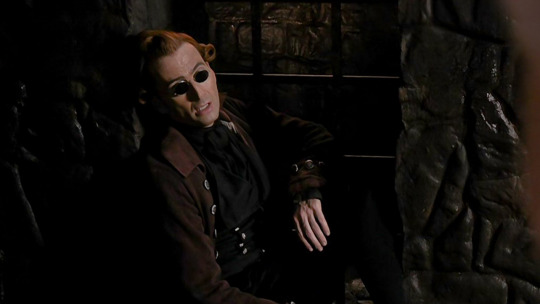
Sir Percy Blakeney, the main character of the novel and the West End play under the same title, leads a double life. Appearing as nothing more than a wealthy fop, in reality he’s a formidable swordsman, a quick-thinking master of disguise and an escape artist. Even his own wife, Marguerite, has no idea.
Unfortunately Marguerite is being blackmailed with her brother’s life to find and expose the wanted Pimpernel. She regrets betraying her husband the moment she's forced to do it and spends the rest of the plot working to save him. She does, they make up, and return together to England.

In Aziraphale and Crowley’s case there was just a short stop for crêpes. But what seems to be an inspiration of a specific scene might as well come up later in the wider perspective of the show, so keep in mind those fragments of the musical’s libretto:
We all are caught in the middle
of one long treacherous riddle.
Can I trust you?
Should you trust me too?...
We shamble on through this hell
taking on more secrets to sell
'til there comes a day
when we sell our souls away.
We seek him here, we seek him there,
Those Frenchies seek him everywhere!
Is he in heaven? Is he in hell?
Where is that damn elusive Pimpernel!
1941
The London Blitz is when we see a full-fledged iteration of the superhero Crowley performing dashing and heroic deeds under the literal cover of darkness and air bomb smoke. In a bespoke double-breasted suit and a fedora — still free from the unfortunate modern connotations from the internet culture — he’s clearly channeling Humphrey Bogart as a private investigator Sam Spade in The Maltese Falcon (1941) now.
It all starts with a woman and a simple plan gone wrong: Spade’s partner is shot dead, just like the man he was supposed to be tailing upon the request of a mysterious Miss Wonderly. And when a very soft-looking, sweet-scented man named Joel Cairo appears in his office willing to pay a hefty price for a "black figure of a bird", Spade starts not only a new job, but also his own quest for truth.
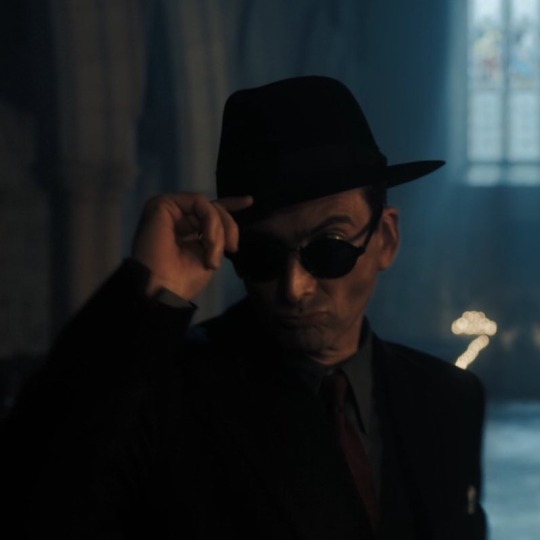
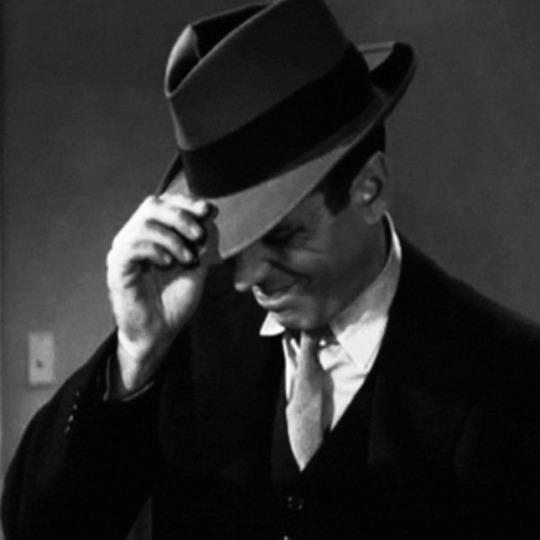
On the surface, The Maltese Falcon ends happily: the killer gets caught, and the hero winds up with the Falcon. But Spade's victory is completely hollow. The Falcon itself, originally meant as a symbol of loyalty, transforms into a symbol of a corrupting, futile, and self-destructive greed that makes people betray their own loyalties.
The treasure is just a worthless forgery and he’s fallen in love with the criminal — one of the first femmes fatales on screen. Despite his feelings for her and a kiss, Spade gives her up and submits the statuette as evidence, describing it as "the stuff that dreams are made of".
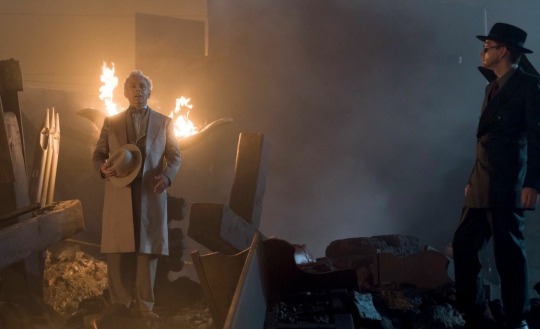
Remember the eagle lectern? The eagle was believed to be flying highest in the sky and therefore closest to heaven, symbolizing the carrying of the word of God to the four corners of the world. Aziraphale in the 1941 church scene is the closest to Heaven we’ve seen him on Earth. Just look at him: dressed in a smart, well-fitted coat with peaked lapels, symbolizing his Heavenly allegiance, and doing good this time not as a work assignment, but of his own accord. Being the closest to Heaven means the furthest and most unattainable for a demon like Crowley.
The Maltese Falcon is a metaphor for unattainability — things out of reach to desire and fight for, although never truly possess. It’s “the stuff that dreams are made of”. But Crowley secured the original — made of gold and encrusted with jewels, but hiding its real value under black enamel — eerily reminiscent of the demon himself and the unending kindness behind his inappropriately tight black clothing.
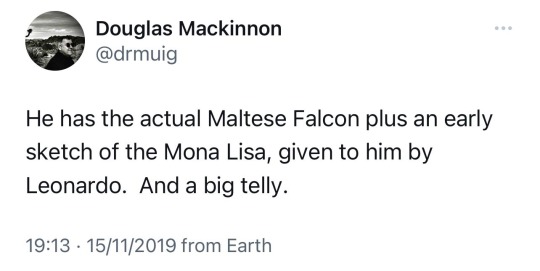
Quoting Michael Ralph — the production mastermind behind Good Omens — from the S01E04 “Saturday Morning Funtime” DVD commentary, “We wanted to tip our hat to the Maltese Falcon as being a precious object that no-one thought really exists but it does”. So we can safely assume that Crowley can and will achieve his dream in the future.
1967
Do you know what else happens in 1941 in Scotland? Ian Fleming, a British naval intelligence agent, meets with the famous occultist Aleister Crowley and asks him to lead the interrogation of newly imprisoned Rudolf Hess — a leading member of the Nazi Party in Nazi Germany appointed Deputy Führer — given the two men’s shared enthusiasm for the occult.
This meeting has a significant impact on Fleming’s work as a writer; Aleister Crowley becomes the inspiration for his first villain Le Chiffre and creates a blueprint for most of the James Bond’s franchise ever since 1953, the publication date of the novel Casino Royale.
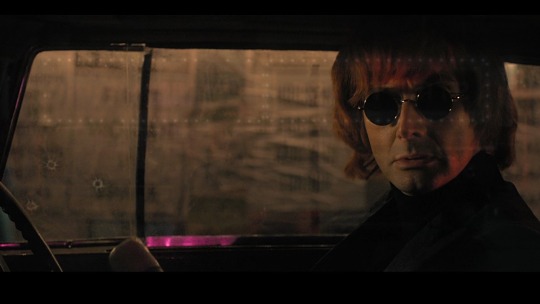
Meanwhile our Anthony J. Crowley believes in himself not being the villain he’s usually and sometimes forcefully painted as, but a superhero in disguise. The character of James Bond in particular inspires him so much that he buys petrol to get the limited You Only Live Twice (1967) window decals for his Bentley, dons his own tactical turtleneck, and sets off to organize a heist like no other. Sean Connery style.
Like a typical superhero, Crowley’s once again both saved and betrayed by his love interest. Aziraphale leaves him with a thermos of Holy Water, a faint smile, and a hope that they’ll soon match their speeds to meet halfway at the Ritz. The cancelled heist is not an ending, but a promise of a new beginning. And the fact that UK decriminalizes homosexual acts in the very same year is more than telling in this regard.
2019
An exceptional situation calls for exceptional solutions, and what’s more important than the impending Apocalypse? Demon Crowley does his best to put the arsenal of his 20th century film inspirations to good use.
"Ask yourself, do you feel lucky?" Crowley drawls, clearly imitating (although slightly misquoting) the titular Dirty Harry (1971). He’s hoping to be menacing and making the point of being the one on the right side of the law and history.
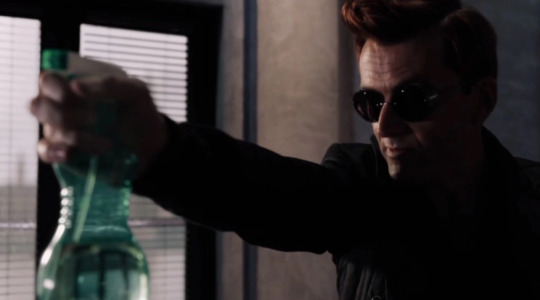
Some situations require more than quoting action heroes is not everything though. He knows what to do:
A jeep was heading purposefully towards the gate, and it looked as though it was crowded with people who were about to shout questions and fire guns and not worry about which order they did this in.
[Crowley] brightened up. This was more what you might call his area of competence.
He took his hands out of his pockets and he raised them like Bruce Lee and then he smiled like Lee Van Cleef.
'Ah,' he said, 'here comes transport.'
When in doubt, Crowley acts. He transforms into a combination of a stoic martial arts phenomenon and a sardonic, menacing character. His smile alone — even on Aziraphale’s angelic face, as seen in one of the final cut scenes — seems to be enough to ward off evil spirits, angels, and humans alike.
But we all know that even as breathtaking performances as those can’t protect anyone from the cogs of the Heavenly machine and its plans.
2023
No wonder that Crowley’s tactical turtleneck comes back in style after mere four years of retirement with a self-introduction “Former Demon, hated by Heaven, loathed by Hell. How will our hero cope?”. Something has changed during this time; he’s more mature now, not playing pretend by hiding behind the usual veneer of sarcasm and movie quotes anymore. Finally comfortable with the fact that this is his own story and there’s no need to become anyone else than himself.
The bookshop fire and the Heavenly trial still seem to haunt the demon in a way that makes him realize what all humans know: that every hero is his own biggest enemy. His ultimate dream might effortlessly change into his greatest nightmare any moment now, and the only thing he can do about it is hover in a two-minute distance from the epicenter of his feelings. But Crowley has no time to work on it when a new mission appears, to protect his angel from Gabriel and the combined powers of Heaven and Hell. Even if this — rather ostentatiously — is the last thing he wants to think about at the moment.
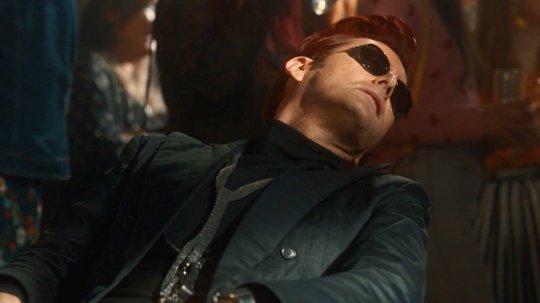
Crowley tries to plan ahead, while his story slowly warps into a different genre due to Aziraphale’s interruptions. He eventually changes back into his usual Henley shirt after agreeing to swap places and guarding the bookshop while the angel is off to Edinburgh, collecting more clues. Did he finish his personal quest off-screen? Did he just give up on it in the whirlwind of matchmaking shenanigans? Remains to be seen.
In the S2 finale our master of disguise in yet another turtleneck proves that he can successfully infiltrate even the universe’s back office. We don’t know where he drives off in the end, but one thing is certain — he’s got a plan. And a world (and his dream) to save, like a superhero he is.
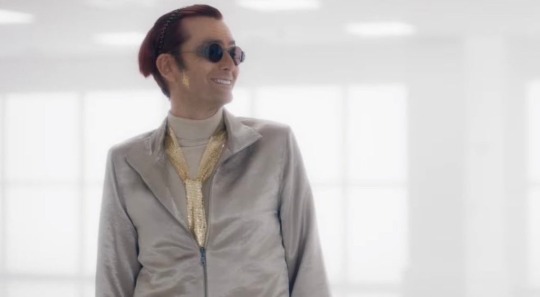
#a turtleneck kind of day#crowley is a superhero#and a master spy#with a plan#good omens#good omens 2#good omens meta#go2 meta#ineffable husbands#crowley#turtleneck crowley#yuri is doing her thing
126 notes
·
View notes
Text
How Magnificent Ms. Marvel deconstructs the "Chosen One" archetype
One element of the Destined arc from Saladin Ahmed's run on Magnificent Ms. Marvel that I find interesting is that it actively subverts orientalist and imperialist tropes present in sci-fi "chosen one saves alien planet" narratives.
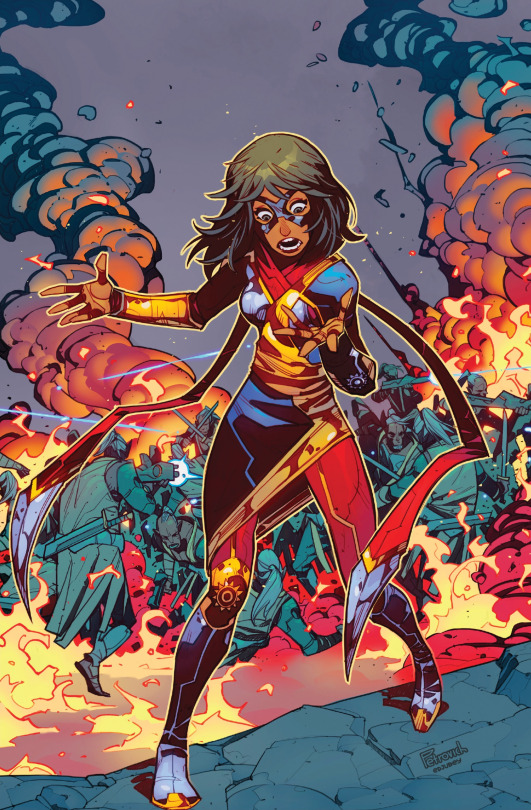
Specifically, the whole idea of a human being whisked away to rescue an entire alien civilization from their own despotic dictator was heavily popularized by the comic-strip/serial show Flash Gordon, which was infamous for its usage of racist Yellow Peril tropes. Like not only was the main antagonist of Flash Gordon, Ming the Merciless, an overtly Yellow-Face Fu-Manchu caricature, but even the name of the planet he ruled, "Mongo," sounds awfully similar to the real-life Asian country of Mongolia. And this is made even more uncomfortable by the fact that Flash Gordon himself is the stereotypically glorified blonde-haired blue-eyed white male, and both the strip and serials portray him as liberating and conquering the planet Mongo from the obviously Asian-coded villain.

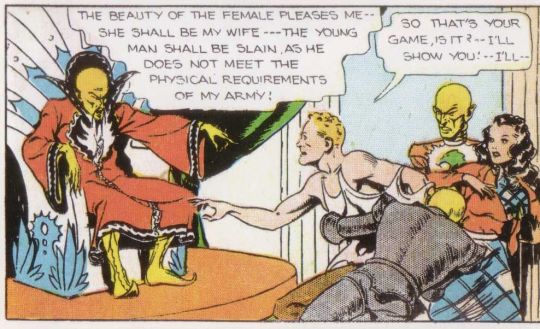
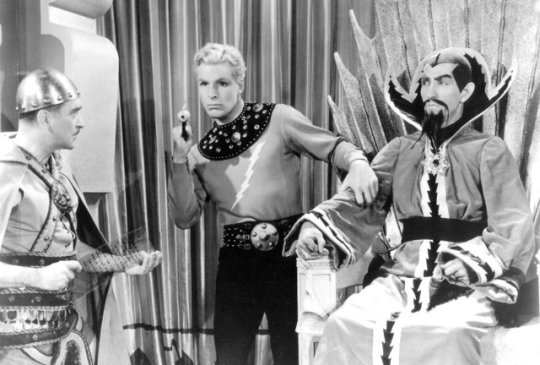
So yeah, there are definitely some imperialist and orientalist trappings within the "human saves alien planet" narrative. However, while the Destined arc of Magnificent Ms. Marvel is clearly modeled after this archetypal narrative, there are plenty of ways in which it both subverts and deconstructs this type of plot IMO. Immediately right off the bat one of the key methods in which Destined avoids the same White Savior trapping as Flash Gordon does is through the fact that although the protagonist Kamala Khan is an American, she's simultaneously a brown Muslim Girl who comes from a first-generation Pakistani immigrant family. So that alone already subverts the traditional "chosen one/savior" archetype by having the main character be a woman of color instead of a white man. Plus the author of Magnificent Ms. Marvel, Saladin Ahmed, is a Lebanese-American Muslim, whereas Flash Gordon's creator, the late Alex Raymond, was a white man.

Furthermore, what also helps the Ms. Marvel arc is that even though the alien civilization of Saffa which Kamala and her parents visit is clearly modeled after Arabic and Middle Eastern cultures, it avoids the orientalist trappings since this coding reads much closer to Kamala's own Muslim identity and the story even draws direct parallels between the two. While of course Pakastini and Arabic cultures are not the same and bear distinctions between each other, there is still some overlap between them especially through shared Islamic traditions, which is a huge deviation and contrast from the clearly all-American Flash Gordon versus the obviously Yellow-Peril inspired Ming the Merciless.

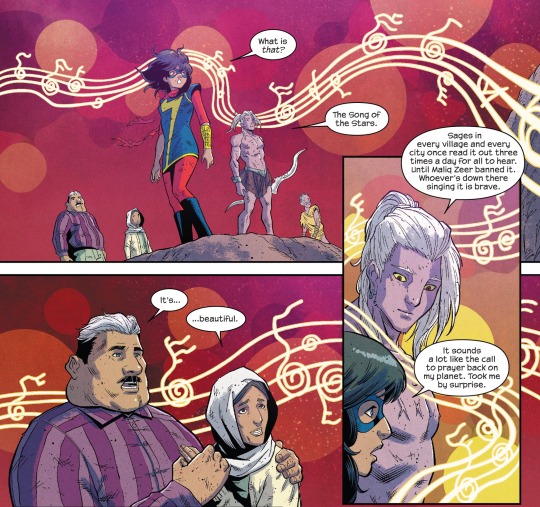
Lastly, in an interesting twist it's actually not the theocratic dictator which Kamala saves the planet Saffa from, but rather from the invading hordes of a rival alien empire who were mentioned in the the "Destined One" legend that the Saffans' believed Kamala was a part of. And the Saffan dictator, Maliq Zeer, who was previously built up in the narrative as the traditional final boss ends up putting aside his own evil agendas in order to prevent his planet's annihilation.
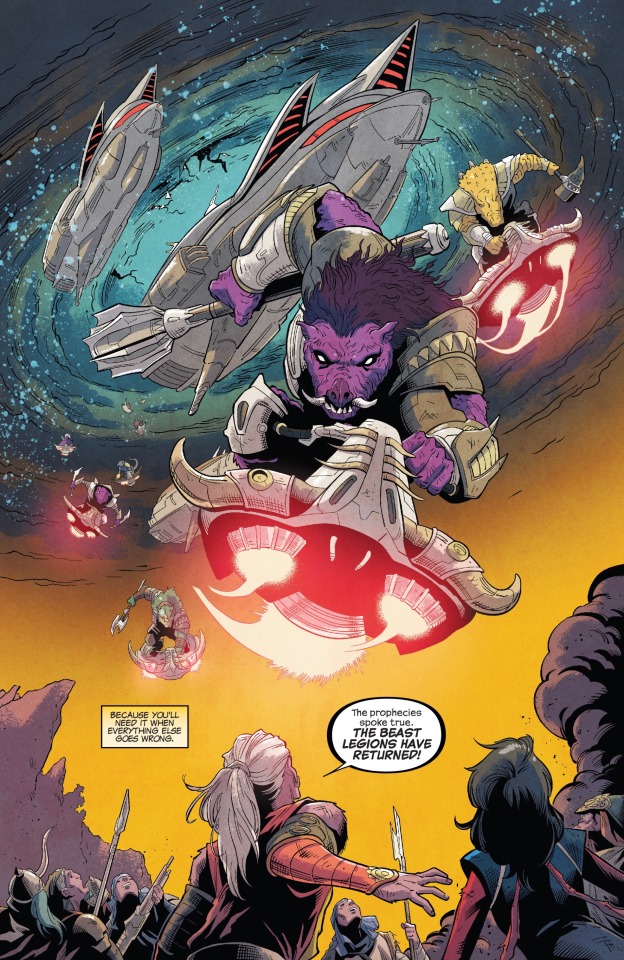
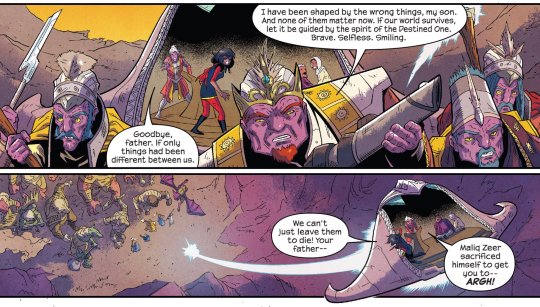
Plus, the entire story is focused on deconstructing the chosen one trope by examining how various other characters view Kamala as a hero, as well as her own struggles with this sort of glorification whilst still trying to protect others simply because its the right thing to do.

And while I've seen some people argue that the Saffan's "magic = Islam" which therefore "intrinsically roots violence in their beliefs and has such messed up connotations," it's outright stated or heavily implied in the Destined arc that that Maliq Zeer and his priest's version of the "Destined One" legend was a perversion of the planet's normal belief system to amass their own political power, which said dictator is willing to put aside when the Beast Legions from the legend return in the arc's climax. Heck, even the aforementioned "call for prayer" that Cheb Hura (Maliq Zeer's son and the leader of a band of rebel freedom fighters) mentioned previously was coded as something positive rather than negative since it was banned by the theocratic dictator.
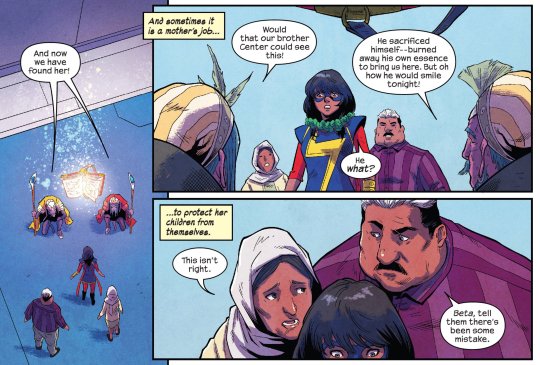

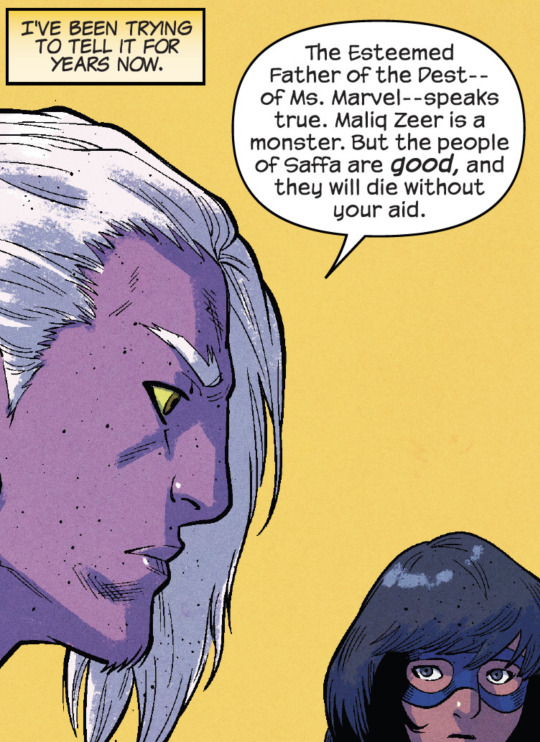

So overall, I personally felt that while Saladin Ahmed’s Destined arc was playing with the “human saves alien civilization” narrative that was typical in old sci-fi serials like Flash Gordon, he simultaneously avoids a lot of the problematic white-savior and imperialist/orientalist tropes which also predominated those older stories due to Kamala’s own status as a Pakistani-American Muslim girl, the subverting of the tropes found in these kinds of narratives, as well as the overall framing around the Arab-coded alien civilization.
#mini essay#ms marvel kamala khan#kamala khan#ms marvel#magnificent ms marvel#yusuf khan#muneeba khan#cheb hura#destined#destined one#sword of saffa#saladin ahmed#minkyu jung#flash gordon#marvel comics#cw: orientalism mention#cw: imperialism mention
15 notes
·
View notes
Text
Evaluation:
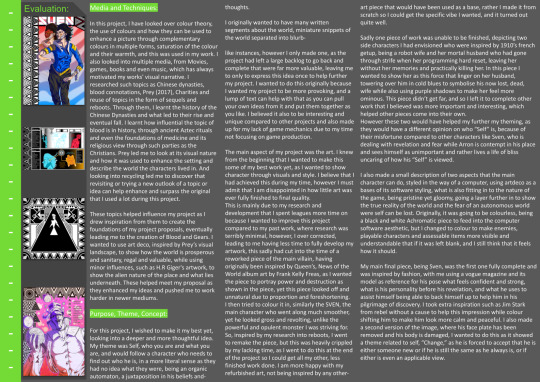

Media and Techniques:
In this project, I have looked over colour theory, the use of colours and how they can be used to enhance a picture through complementary colours in multiple forms, saturation of the colour and their warmth, and this was used in my work. I also looked into multiple media, from Movies, games, books and even music, which has always motivated my works' visual narrative. I researched such topics as Chinese dynasties, blood connotations, Prey (2017), Charities and reuse of topics in the form of sequels and reboots. Through them, I learnt the history of the Chinese Dynasties and what led to their rise and eventual fall. I learnt how influential the topic of blood is in history, through ancient Aztec rituals and even the foundations of medicine and its religious view through such parties as the Christians. Prey led me to look at its visual nature and how it was used to enhance the setting and describe the world the characters lived in. And looking into recycling led me to discover that revisiting or trying a new outlook of a topic or idea can help enhance and surpass the original that I used a lot during this project.
These topics helped influence my project as I drew inspiration from them to create the foundations of my project proposals, eventually leading me to the creation of Blood and Gears. I wanted to use art deco, inspired by Prey’s visual landscape, to show how the world is prosperous and sanitary, regal and valuable, while using minor influences, such as H.R Giger's artwork, to show the alien nature of the place and what lies underneath. These helped meet my proposal as they enhanced my ideas and pushed me to work harder in newer mediums.
Purpose, Theme, Concept:
For this project, I wished to make it my best yet, looking into a deeper and more thoughtful idea. My theme was Self, who you are and what you are, and would follow a character who needs to find out who he is, in a more literal sense as they had no idea what they were, being an organic automaton, a juxtaposition in his beliefs and thoughts.
I originally wanted to have many written segments about the world, miniature snippets of the world separated into blurb-
like instances, however I only made one, as the project had left a large backlog to go back and complete that were far more valuable, leaving me to only to express this idea once to help further my project. I wanted to do this originally because I wanted my project to be more provoking, and a lump of text can help with that as you can pull your own ideas from it and put them together as you like. I believed it also to be interesting and unique compared to other projects and also made up for my lack of game mechanics due to my time not focusing on game production.
The main aspect of my project was the art. I knew from the beginning that I wanted to make this some of my best work yet, as I wanted to show character through visuals and style. I believe that I had achieved this during my time, however I must admit that I am disappointed in how little art was ever fully finished to final quality.
This is mainly due to my research and development that I spent leagues more time on because I wanted to improve this project compared to my past work, where research was terribly minimal, however, I over corrected, leading to me having less time to fully develop my artwork, this sadly had cut into the time of a reworked piece of the main villain, having originally been inspired by Queen’s, News of the World album art by Frank Kelly Freas, as I wanted the piece to portray power and destruction as shown in the piece, yet this piece looked off and unnatural due to proportion and foreshortening.
I then tried to colour it in, similarly the SVEN, the main character who went along much smoother, yet he looked gross and revolting, unlike the powerful and opulent monster I was striving for. So, inspired by my research into reboots, I went to remake the piece, but this was heavily crippled by my lacking time, as I went to do this at the end of the project so I could get all my other, less finished work done. I am more happy with my refurbished art, not being inspired by any other art piece that would have been used as a base, rather I made it from scratch so I could get the specific vibe I wanted, and it turned out quite well.
Sadly one piece of work was unable to be finished, depicting two side characters I had envisioned who were inspired by 1910’s french getup, being a robot wife and her mortal husband who had gone through strife when her programming hard reset, leaving her without her memories and practically killing her. In this piece I wanted to show her as this force that linger on her husband, towering over him in cold blues to symbolise his now lost, dead, wife while also using purple shadows to make her feel more ominous. This piece didn’t get far, and so I left it to complete other work that I believed was more important and interesting, which helped other pieces come into their own.
However these two would have helped my further my theming, as they would have a different opinion on who “Self” is, because of their misfortune compared to other characters like Sven, who is dealing with revelation and fear while Arron is contempt in his place and sees himself as unimportant and rather lives a life of bliss uncaring of how his “Self” is viewed.
I also made a small description of two aspects that the main character can do, styled in the way of a computer, using art deco as a bases of its software styling, what is also fitting in to the nature of the game, being pristine yet gloomy, going a layer further in to show the true reality of the world and the fear of an autonomous world were self can be lost. Originally, it was going to be colourless, being a black and white Achromatic piece to feed into the computer software aesthetic, but I changed to colour to make enemies, playable characters and assessable items more visible and understandable that if it was left blank, and I still think that it feels how it should.
My main final piece, being Sven, was the first one fully complete and was inspired by fashion, with me using a vogue magazine and its model as reference for his pose what feels confident and strong, what is his personality before his revelation, and what he uses to assist himself being able to back himself up to help him in his pilgrimage of discovery. I took extra inspiration such as Jim Stark from rebel without a cause to help this impression while colour shifting him to make him look more calm and peaceful. I also made a second version of the image, where his face plate has been removed and his body is damaged, I wanted to do this as it showed a theme related to self, “Change,” as he is forced to accept that he is either someone new or if he is still the same as he always is, or if either is even an applicable view.
Outcome:
By the outcome, I am mixed on my feelings about this project. I have had excellent highs but also depressive bouts about the project's size, quality and overall skill. I wished to put my all into this, and make some of my best work, but being here shows that I am knowledgeable about my own projects' worth. Some aspects, such as some of my art and especially my research makes me feel proud and accomplished, but my writing skills and talents, including the wasted work, feel horrible to experience. If I was to go back to my project proposal, I think my past self would be disappointed with how it turned out, it feels lacking in areas and hasn't followed the timetable I made for it, but they never seem to match considering how projects never go to plan, always seeming to diverge into tangents and worthless work.
I believe that it has not fully met the FMP brief, but I don't see that as a negative, as it has become its own creature, allowing it to evolve further and flourish into its own identity, further and grander than that of which I tried to make it.
Conclusion:
I have received minimal feedback on my work and no peer assessment due to my lacking drive or care for others onions, as my own opinion of my work is far more valuable, as I am not one to sugar-coat what I think is bad, and I would know due to my hatred for my work, looking back at some of them I can see faults such as anatomy and proportion or just ugly decisions that I seeked out. This hatred for my art is what led me to remake my second piece and to throw other pieces into the trash. To improve my project, I could have spent longer positions and posing my characters, making them feel less stilted, this could have been exceptionally helped by using better facial expressions that would have better helped portray their emotions. I have learnt that wasting my time is worthless, even If I believe it would help enhance a piece, as I will only grow to despise it as time goes on.
Citations
Rebel without a cause (1955).
Jamiroquai (2017) “Automaton,” Music - Automaton Lyrics [Preprint]. Genius. Available at: https://genius.com/Jamiroquai-automaton-lyrics (Accessed: March 7, 2023).
National Geographic Society (2023) Imperial China's dynasties, Education. National Geographic. Available at: https://education.nationalgeographic.org/resource/imperial-chinas-dynasties/ (Accessed: March 7, 2023).
Arkane Studios (2017) Prey, Video Game.Bethesda Softworks. Available at: Prey on Steam (steampowered.com) (Accessed: March 7, 2023).
Wikipedia (ed.) (2023) Dynasties in Chinese history, Wikipedia. Wikimedia Foundation. Available at: https://en.wikipedia.org/wiki/Dynasties_in_Chinese_history (Accessed: March 7, 2023).
Guillermo del Toro's Pinocchio (2022) IMDb. IMDb.com. Available at: https://www.imdb.com/title/tt1488589/ (Accessed: March 7, 2023).
H.R. Giger (no date) Artnet.com. Artnet Worldwide Corporation. Available at: https://www.artnet.com/artists/hans-rudolf-giger/ (Accessed: March 7, 2023).
Houston, D. (2020) The Complete Guide to silver - spiritual meaning, properties and powers, CrystalsandJewelry.com. Available at: https://meanings.crystalsandjewelry.com/silver/ (Accessed: March 7, 2023).
Goryainov, D. (2020) Destiny 2 beyond light- stasis, Dima Goryainov on artstation at https://www.artstation.com/artwork/48djjn: Destiny, artwork, concept art, Pinterest. Epic Games. Available at: https://www.pinterest.co.uk/pin/406942516337017173/ (Accessed: March 7, 2023).
“Leviticus 17:11” (1986) in The holy bible: Containing the old and new testaments ; translated out of the original tongues and with the former translations diligently compared and revised. New York: American Bible Society.
Niki Clarke, N. (2019) Free online mental health chat, support & help, My Black Dog. Available at: https://www.myblackdog.co/ (Accessed: March 7, 2023).
Toy Story 2 (1999) IMDb. IMDb.com. Available at: https://www.imdb.com/title/tt0120363/?ref_=ttfc_fc_tt (Accessed: March 7, 2023).
Bungie (2017) Destiny 2, Video Game. Bungie. Available at: Destiny 2 on Steam (steampowered.com)(Accessed: March 7, 2023).
Cancer research UK (no date) Cancer Research UK. Available at: https://www.cancerresearchuk.org/ (Accessed: March 7, 2023).
LeFauve, M. (2015) Inside Out, IMDb. IMDb.com. Available at: https://www.imdb.com/title/tt2096673/ (Accessed: March 7, 2023).
Hirsch, A., McKeon, T. and Chapman, M. (2013) Gravity Falls. Disney Channel.
Zöllner Frank, Thoenes, C. and Taschen, B. (2022) Michelangelo: The Complete Works: Paintings, sculptures, architecture. Keulen: Taschen.
Frank Kelly Freas, (28, 10, 1977) News of the World, Queen.
Vogue, (2, 10, 2010) Vogue magazine, Vogue
0 notes
Text
The Library of Tusken Lore
Compiled by Bailey aka @kotemorons
Preface
George Lucas was wrong. Yes, I know he made Star Wars but the way he went about a surprising amount of things in it was very, very wrong. He had the right idea to take inspiration for a desert-dwelling indigenous culture from another desert-dwelling indigenous culture, but aside from costuming and basic props, the rest of the initial execution of the Tusken Raiders was flat-out wrong. He did not give them a language, the way he co-opted Xhosa for Geonosians, he instead had them speak in donkey brays and whines. Combining the rich imagery of Bedouin nomads with connotatively disrespectful noises for this culture’s language really speaks on how much effort was put into creating the Tuskens. Even the name we’re first given for them, ‘Raiders’ (not to mention the incredibly offensive ‘Sand People’) implies a violent, single-faceted motivation for their entire tribe group. Anyone who’s studied nomadic or indigenous cultures from an ethical standpoint can tell you that this reductive description is just plain wrong.
The recent Mandalorian series has started to patch the wounds of bad worldbuilding Lucas left on the Tuskens. They’ve given credence to a culture that would have difficulty hearing one another or reading lips, by building a novel form of sign language, and have involved them in hero arcs (killing a Krayt Dragon and teaming up with once-enemies) rather than the villain arcs we’ve seen them in before (Shmi Skywalker’s kidnapping and death, and knocking out Luke Skywalker in the Jundland wastes). This has ignited a new interest in Tuskens, and unfortunately, has also led to the unfortunate discovery that everything canon has to say about Tuskens is wrong.
Sorry not sorry, LFL. My friends and I are hijacking Tusken lore. Deal.
This library is sorted into several parts: The Cherry-Picked Canon, The Disney Canon, and the New Fanon. I hope this resource will help you in your own worldbuilding efforts. If you’re worried about possibly creating an insensitive representation of Tuskens, going in with positive intent (that is, the intent to depict them positively) is a battle half-won. The fact that you would worry about it at all is a critical-enough eye in my book.
So let’s find out what’s right.
The Cherry-Picked Canon
I’ve collected quite a few books about Star Wars. There’s an extremely rich amount of archival work that details the most intricate facts and figures you probably didn’t even know you didn’t know. Unfortunately, most of the information in these books about Tuskens is (as mentioned above) wrong. However, there are still some edible bits I’ve found that one can stomach. The below are those h’ors d'oeuvres.
What’s In a Name? A Tusken By Any Other Would Still Kill You
Tuskens weren’t always called that. The name is derived from the second settlement on Tatooine, Fort Tusken, which was attacked by the not-yet-eponymous raiders. In the wake of this attack, the raiders were given the nickname Tuskens, and it stuck for several hundred years after. (Vitas, 525) Several books in Legends call them the Sand People or Sandpeople, but I don’t like that so we’re sticking with Tuskens. It’s entirely possible that through cultural and linguistic determinism, the Tuskens eventually adopted that name for themselves, but it’s as yet unknown what they call themselves.
The name Tatooine comes from the Jawa name for the planet, Tah doo Een e, but it’s unknown what that means. (Vitas, 1507) By this linguistic history, it’s unlikely that the Tuskens would call themselves any variation of “Tatooinian” either. Tuskens make up only 5% of the entire population of Tatooine, while humans make up 70%. (Wallace and Fry, 118)
The first appearance of the name Tuskens actually comes from the very first rough draft of Star Wars, though the name was given to a group of elite Imperial troopers sent to hunt down Deak Starkiller’s allies and family. In the second draft, they became a specialized Imperial reconnaissance team. (Vitas, 1818)
According to Wookieepedia (which you should always take with a grain of sand) Tuskens have always been on Tatooine, and have been called Sand People since at least around 4000 BBY, during the Old Republic. Another uncited source on the wiki refers to Tuskens as Ghorfa to denote an earlier sedentary phase of their culture, and before then, shared a common ancestral species with the Jawa in the Kumamgah.
Culture, Clans, and History
Most books make frequent mention of the Tuskens’ way of life being violent, rigid, and unchanged over thousands of years. For instance, clan storyteller is one of the most important, and rigorously-trained positions in the entire clan structure, and the rites to become a storyteller are even more strenuous than that of a warrior or a fighter. To make even a single mistake while reciting the stories is known to have been met with death. Tradition and culture are very important to the Tuskens, and since they have no written language, storytelling is the only means of keeping their histories in the collective memory.
While nearly every book that mentions them speaks on their intense nomadic style, Tuskens are known to come into more-populated parts of Tatooine as well, and several locations around Tatooine (including Tosche Station) have bantha hitches outside. The rumored source of the centuries-long blood war between Tuskens and human colonizers (in addition to the whole colonization thing) lies with the first usurber of the B’omarr monastery in the Western Dune Sea, known more colloquially as Jabba’s Palace. The usurper, a bandit named Alkhara, had allied himself with the Tuskens to wipe out a police garrison near the former capital of Tatooine. After the successful incursion, Alkhara butchered the Tuskens who had helped him, and tensions have been unable to be settled since.
Like most tribes and cultures, Tuskens have a few “coming of age” rituals. Many children die in the harsh conditions on Tatooine, and only the strongest reach adulthood, and only the strongest of those survive their rites of passage. While many books like to specify that the only rite of passage for Tusken adulthood is killing a krayt dragon, this isn’t true. If it were, there would be no Krayt dragons left on Tatooine, and therefore no blooded Tuskens. Instead, Tusken rites of passage involve some great feat of skill or prowess, the magnitude of which determines their station among the clan. Common rituals involve raiding settlements for trophies, ambushing stormtrooper squadrons, completing great treks unassisted by the tribe, or protecting the tribe from attack. These kinds of things are buildable on a Tusken’s honor, so the more feats under one’s belt, the greater their rank in the clan will be. (McQuarrie & Anderson, 43)
One interesting coming-of-age tale observed by Senior Anthropologist Hoole is described in full here:
A solemn ceremony was held to prepare two Tusken youths for their journey into the wilderness. They were given totems, armaments, and water. Saying no words, and showing no fear, they mounted their banthas and headed off into the wilderness. The rest of the clan watched until the youths disappeared on the horizon, then returned to their lives as if it were a normal day. Several weeks passed, and the [Tuskens] said nothing of the two youngsters who had left them. Since they were not seen as people until they passed their test, no one would acknowledge them. Then, one day, a solitary figure on a bantha appeared on the horizon. One youth had returned, carrying on his mount the armor and weapons of four Imperial stormtroopers. Raucous activity erupted among the tribe’s membership. A bonfire was lit, food was prepared, and amidst great ceremony, the storyteller added the young Tusken’s story of bravery to the tribal history. Again, no word was mentioned about the other youth who did not return. It was as if he had never existed. (Lewis & Post, 151)
It’s important that the ethics of Hoole’s ethnographic research must be called into question. Hoole is of a species which can shapeshift, and he has spent many years disguising himself as a member of the different culture groups he is studying. This violates the informed consent of the observed group, and can (and will) result in extreme violence when unmasked. His embed with the Tuskens most likely forewent a great deal of context, which Hoole could not ask about or request clarity on without sacrificing his safety. As such, this perceived disinterest in the two young Tuskens lacks any kind of emotional context or depth which the Tuskens could have explained. And people wonder why they’re so secretive.
They are also known to dance around bonfires, and wear “spirit masks” fashioned from natural materials to use in rituals. Each tribe is different, and has unique traditions they practice.
Tusken clans are made up of 20-30 individuals on average, and travel in a straight line on bantha-back to hide their numbers in the sands. They make camp in natural rock formations, or in temporary tent shelters (called urtya) built from bones, hardened wood, bantha hide, and mud. Scouting groups typically went out in groups of two or three. Some Tuskens have taken over existing encampments they’d looted from settlers, like Fort Tusken, of which they bear their names from. In the summer months on Tatooine, they often seek more semi-permanent shelters, as to better accumulate rations, food, water, and supplies in the harsher months. Tuskens protect their oases on Tatooine with a ferocity unmatched by the other inhabitants. They believe the water to be sacred, and promised to them. One canyon in particular, Gafsa, contained a rare water well, and was fiercely guarded. The translation of Gafsa in Tusken means ‘the waking place’, which most likely makes it the cradle of civilization on Tatooine.
In addition to their own species, Tuskens often travel with any number of animals, including bantha, massiffs (large dog-sized reptilian creatures), and sandbats, which they use for their venom. It’s important to note that often in desert nomadic tribes, they travel with cats in order to keep pests at bay and to keep as companions. It wouldn’t be out of the norm to see a sand-tooka or two among individual tribes.
While the entirety of Tatooine is their home, Tuskens do avoid certain places. Near Mos Espa and on the infamous porracing track, there is an astonishing natural land feature called Mushroom Mesa by the settlers. Tuskens avoid the place as if it were cursed, but nobody seems to know why. (Lund, 10) Most of the areas on Tatooine inhabited by colonizers are avoided, though there are some places, like the Sacred Pinnacle standing within the center of the Mos Espa Arena, that were once pilgrimage sites full of caves for Tuskens to perform spiritual ceremonies and promote successful hunting seasons and prosperity. They’d long been chased out by the roar of podracer engines and tourists, but modern-day Tuskens regularly shoot at Podracers during competitions to avenge their ancestors, another coming-of-age ritual often achieved during the Boonta Eve Classic. (Lund, 14)
Another holy site for Tuskens is located in the Jundland Wastes. Ninety meters high and formed by ancient drainage channels, the B’Thazoshe Bridge (translated to “bantha horn turned to stone”) is the largest natural bridge on tatooine, and is considered a sacred site to Tuskens. It also marks the boundary of the Tuskens’ ancient hunting territory. Like allied sloops-of-war, Tuskens would let off rounds of blast fire before passing through in order to purge ill intent from their souls. To not do so would bring bad luck on the tribe. (Beecroft, 14)
From early childhood, the Tuskens wrap their faces and bodies in rags, cloth, and other protective gear, to ensure survival in the harsh Tatooine deserts. They see through eye filters which protrude from their faces, and wear masks to filter sand particles. Some books mention an almost religious adherence to keeping their faces and bodies covered, only revealing their appearances to their spouse in the privacy of their tent once they are wed.
Their relationships to their bantha are just as sacred as one’s relationship to their spiritual leaders. Younger banthas are cared for by Tusken children (known as Uli-ah), but upon reaching maturity, one Tusken and one bantha will be teamed together, and the emotional bond between the pair is difficult to endure separation from one another. Their bonds are so intertwined, that upon the other’s death, the remaining soul will fly into a rage, taking out any poor creature in its grief. Some Tuskens, upon the death of their bantha, will strike out into the desert alone on a vision quest, and if the bantha spirit wants that Tusken to join them in the afterlife, the Tusken will die. If not, another bantha will join that Tusken and allow them to continue living, and return to the tribe, reborn. Luckily, the lifespan of a bantha is around 80-100 years. Their horns grow at the rate of about a knob a year, and can go without food or water for several weeks, makingem well-suited to life on Tatooine. Bantha are also matriarchal, and wild banthas are led by a dominant female. (Hidalgo, 24)
The language of the Tuskens is made mostly of chants and gestures, dissimilar to any known language so far. More about the Tusken sign language will be in the Disney Canon section. Historically, Tusken names begin with one of three letters (in our alphabet): A’ (like A’Sharad, and A’Yuqw) for men, R’ for women, and U’ for unisex or nonbinary names. K’ can also mean daughter of, and A’ can mean son of. Some sources say Tuskens also know rudimentary knowledge of Huttese and Jawaese, as they came into contact with these languages quite frequently. Some protocol droids could be equipped with a Tusken language pack, allowing them to speak and translate the Tusken language.
Tools, Tech, and Weapons
Tuskens seem to favor two types of weapons: gaderffii, or gaffi sticks, and projectile hunting rifles also known as slugthrowers. Some books mention that Tuskens build both by hand, and are reinforced by rare tractl wood only found in hidden Tusken oases. Because of the sturdiness of these Tusken rifles, they can also be used as melee weapons, though the gaderffii seems to be the favored weapon there. (Blackman, Weapons and Technology, 47)
The gaderffii is the most visible symbol of the Tuskens, as it’s the traditional weapon for every tribe. They’re short polearms, with one edge sporting a double- or triple-edged axe and spearing blade, and the other end bearing a weighted club and stabbing blade. This combination gives Tuskens the ability to initiate nearly any type of attack. The spearing blade (axe end) is used to fend off large predators or to attack from a bantha at full charge. The stabbing blade (club end) is used to carve into rock to denote territory, or, as shown in The Mandalorian (S2E01: The Marshall), as a bantha toothpick. Gotta keep those teeth clean. The axe is capable of decapitation or limb severing, as well as cutting into thick tree trunks and foliage. The club can be used to stun prey, knock victims to the ground, or crush stormtrooper plastoid armor into a billion pieces. Some Tuskens dip the bladed edges in sandbat venom to increase this weapon’s lethality. (Blackman, Weapons and Technology, 73)
The crafting of a gaderffii can be made from practically anything, like most bladed weapons over history. They can be made from scavenged durasteel, krayt dragon bones or horns, solid tractl wood, or anything else found in the Tatooine wastelands. Nomadic tribes don’t often have access to armories and weapons shops, so they have to make do with what’s available. They are used not only for acts of violence, but in everyday settings as well: grinding and digging up food, cracking open hubba gourds, and even in the intimidation displays to determine clan ranking. Typically, Tusken chieftains carry the largest gaderffii in the tribe. (Blackman, Weapons and Technology, 73)
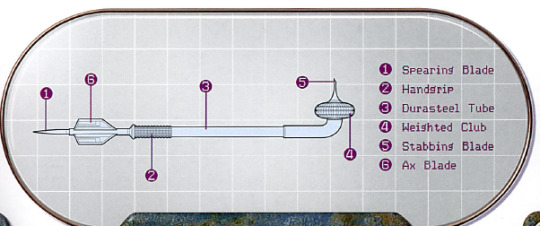
Some books mention a “Tusken aversion to technology” but it seems rather misinterpreted: not many nomad groups would want anything to do with delicate circuitry that may get ruined by sands. Even now, Bedouin tribes and other Northern Sahara tribes find Nokia phones reliable, though they’re quite anachronistic by “modern” society. (McQuarrie & Anderson, 21) Their lack of a reliance on moisture farming machines like vaporators means that they closely and fiercely guard the oases in the Dune Sea and beyond.
Tuskens do not often use landspeeders, speederbikes, or swoop bikes for that reason. A lack of reliable fuel and an inability to keep sand out of the machinery makes them more of a hassle than a luxury. Instead, they rely on banthas, great furry and horned creatures the Tuskens have domesticated over thousands of years. It’s been proven incredibly difficult for anybody but the Tuskens to try to train them, as the secrets for bantha-rearing are as closely guarded as the locations of their sacred oases. (McQuarrie & Anderson, 29)
Some books mention that the Tuskens could have simply commandeered one of the sturdy Jawa sandcrawlers, great rolling fortresses run by the diminutive native species. The issue here is that while the Jawas are all-around smaller than the average human, Tuskens are just the opposite. Their species (unspecified) is anywhere from a half-foot to a foot-and-a-half taller than most humans. Banthas have no overhead to bonk their heads on, so banthas will do. Sandcrawlers had at one point been ore-hauling vehicles, but the near-total takeover by the Jawas and the further renovations they’d done to the insides made them near-inhospitable for anybody taller than four feet.
Notable Tuskens
Sharad Hett
One of the few humans ever to willingly join the Tuskens, his place among them won through great combat prowess. Hett was a former Jedi Knight who exiled himself on Tatooine after the destruction of his homeworld. He rose to be a clan leader and was eventually killed in an altercation during Gardulla the Hutt’s attempt to overthrow Jabba’s reign. (Ryder, Ultimate Visual Guide, 27) He had a wife, K’Sheek, a human woman who had been adopted into Tusken culture when she was a girl. His son, A’Sharad Hett, was also raised Tusken.
A’Sharad Hett
Son of former Jedi Knight Sharad Hett, he was raised on Tatooine until his father’s death, where he was brought to Coruscant by Jedi Master Ki-Adi-Mundi. He stayed true to both his Tusken upbringing as well as his Jedi training throughout his life. Decades after his father’s death, he would eventually fall to the dark side and become Darth Krayt, named for the krayt dragon on his homeworld.
The Disney Canon
When Disney acquired the rights to all Lucasfilm properties, including Star Wars, it was met with a lot of skepticism. Five movies, a final season of the Clone Wars, and Star Wars: Rebels later, we still haven’t heard more about the Tuskens. Cool. But then, as the flagship series on their new streaming service, Disney+, The Mandalorian opened a new door to as-yet-unexplored Star Wars lore far away from any Skywalkers or Jedi. It was an incredible surprise that the protagonist not only visited Tatooine, but was able to communicate with both native species (Jawa and Tuskens) in two different episodes! He offered no personal judgment on the Tuskens, didn’t even call them Sand People, like his conniving counterpart, Toro Calican. He negotiated calmly and respected their ways, and they respected his life.
It was bittersweet knowing we were seeing probably the end of our glimpse of Tuskens again on the show, but SURPRISE! More Tuskens in the Season 2 premiere! Not only that, they were seen as heroes, and were a vital part to the protagonist’s victory over the krayt dragon. With a little positive attention back on the Tuskens, fan interest exploded over it.
TSL
In addition to formulating an entirely new form of sign language with the hiring of an actual Deaf actor, Troy Kotsur. In fact, his involvement with the series goes all the way back to Season 1, and Kotsur played the Tusken who signed back and forth with the Mandalorian in negotiations for passage through the Dune Sea. Known lovingly as TSL (Tusken Sign Language), a very active Facebook group devoted to learning the language sprung up in November 2020.
Disclaimer: I do not know ASL or any other sign language, but I’m going to try and attempt to describe what the language looks like, and how communication works between Tuskens.
Kotsur makes mention of the development for the language NOT being like ASL, but the sign for “Mandalorian” is based on the helmet and letter-sign for M. In practice, you hold the three middle fingers of your right hand (index, middle, and ring) straight out, while linking your pinky and thumb together. Then, you make a motion from right to left across your eyeline with the sign, and then down the center of your face, top to bottom, like you’re tracing a Mandalorian helmet visor.
Here is a post that seems to be approved of in the TSL Facebook group:

The above post has not been confirmed by TSL creator Troy Kotsur, though he is a member of the group. I’ll update this with other info as it comes up.
Boba Fett… Tusken?
With the hint at the end of Mandalorian Chapter 5: The Gunslinger implying that Boba Fett had made it out of the Sarlacc, speculation rose and rose. At the end of Chapter 9: The Marshall, however, we got confirmation: Boba is back… and apparently shopped at the same place the Tuskens did. He was pictured against the binary sunset, wearing black robes in a similar style to that of the Tuskens, and bearing a long-barreled rifle and gaderffii, just like the Tuskens we’d seen helping Mos Pelgo against the Krayt Dragon. When he again showed up in Chapter 14: The Tragedy, we got to see him use the business end of both weapons against a legion of stormtroopers.
Many questions about Boba Fett’s revenant return were left unanswered, and had no sign of being resolved anytime soon. The show couldn’t have possibly gone back to Tatooine a third time, right?
Wrong, of course. The post-credits sneak preview of Boba Fett and his new associate, the undead Fennec Shand, swooping in to take over Jabba’s Palace. The Book of Boba Fett is set to release on Disney+ in December, and hopefully we’ll see just how the quiet bounty hunter came by those robes and weapons. More speculation in the Fanon section, though.
Obi-wan Kenobi
Another Disney+ mini-series being released in early 2022, this show is rumored to take place entirely on Tatooine, and as a result, we may get more canon lore on the way!
The New Fanon
Obviously since there are some gaps in the story, there’s a natural inclination to lean into fanworks. Here are some fanworks that do an excellent job characterizing Tuskens from fanfic writers.
moments before the wind - kotemorons (Rating: Mature)
Had to plug my own fic in here. Tuskens are in named tribes that know of one another, and there is a spiritual leader named the Eater who exorcises darkness from certain Tusken souls. Din Djarin, the Mandalorian, and Boba Fett, both spent a significant amount of time with the Tuskens and are fully-blooded in their cultures, and share in that cultural common ground.
Atin’tuur - kyberpistol (Rating: Teen and Up) @kyberpistol
Boba Fett is taken in by a clan of Tuskens, and is healed after the sarlacc. He meets another clone who had deserted from the war, and had joined the Tusken tribe. Excellent characterization of Tusken medicine and care. Just because a culture is nomadic and averse to technology doesn’t mean they can’t still provide medical care.
a simple thing - iridan (Rating: Explicit) @ryehouses
This is a kinky BobaDin fic, and it has amazing Tusken lore baked into it. The author’s notes on their crafting of Tusken imagery is very well-researched, and a delight. There aren’t many purely-lore chapters, but it’s a great read.
A Wandered Man, Call Me Sand - Johayc (Rating: Teen and Up) (I don't know if they have a Tumblr!)
Din Djarin and Grogu seek shelter after the opening events of The Mandalorian Chapter 10: The Passenger. Embedded with a Tusken group, he befriends and learns more about them, and their similarities to his own culture.
The Theory of Harmony - robotboy (Rating: Explicit) @r0b0tb0y
Deaf Din Djarin has spent time with the Tuskens, and learned their signs. This fic uses Auslan (Australian Sign Language) but does an excellent job at explaining reasons behind using signs that work extremely well with canon’s non-explanations.
If you know of another fic that deserves to be on here, please let me know!
Bibliography of Disappointments
Beecroft, Simon. Inside the Worlds of Star Wars: Episode II: Attack of the Clones. DK Books. 2003.
Blackman, W. Haden. Star Wars: The New Essential Guide to Weapons & Technology. Del Rey Books. 2004.
Hidalgo, Pablo. Star Wars Character Encyclopedia. DK Books. 2016.
Lewis, Ann Margaret & Post, R.K. Star Wars: The Essential Guide to Alien Species. Del Rey Books. 2001.
Lund, Kristen. Inside the Worlds of Star Wars: Episode I: The Phantom Menace. DK Books. 2000.
McQuarrie, Ralph & Anderson, Kevin J. The Illustrated Star Wars. Bantam Books. 1997.
Reynolds, David West. Star Wars: Attack of the Clones: The Visual Dictionary. DK Books. 2002.
Ryder, Windham. Star Wars: The Ultimate Visual Guide. DK Books. 2005.
Vitas, Bob. The Completely Unofficial Star Wars Encyclopedia v2.03. Unknown Publisher. 2000.
Wallace, Daniel & Fry, Jason. Star Wars: The Essential Atlas.
A Final Note
Tuskens are obviously a rich and underdeveloped part of Star Wars Culture, despite them being there from the start, back in 1977. I’m not going to tell you to stick to canon like glue (I’d be a hypocrite) but I do encourage you to find inspiration from other existing nomadic cultures, and indigenous desert tribes. You’ll learn something amazing, I promise. When making your own interpretations of Tuskens, ask yourself if it’s at all a stereotype or lazy characterization for a desert tribe. If the answer is anything but no, dig a little deeper. Thank you.
If you have anything else you would like to add to the collective lore I’ve written about here, please let me know.
Love,
Bailey
#tusken raiders#star wars lore#star wars#canon is disappointing#i have co-opted tuskens and you can't have them back george#my writing#reference
571 notes
·
View notes
Photo
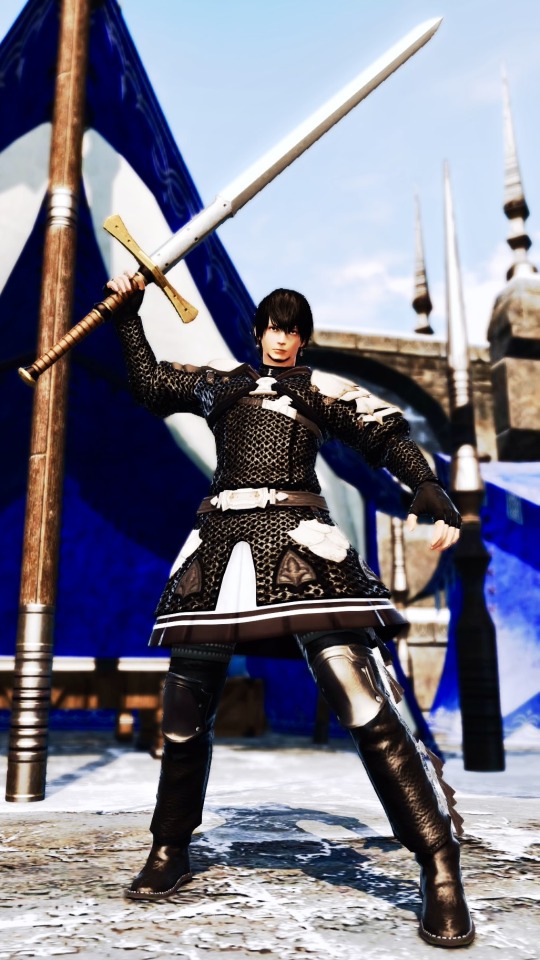

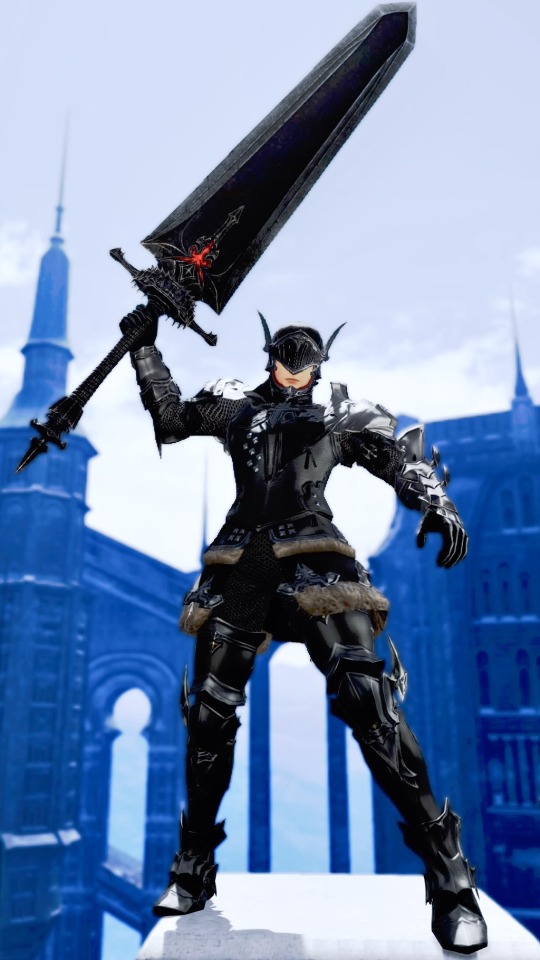
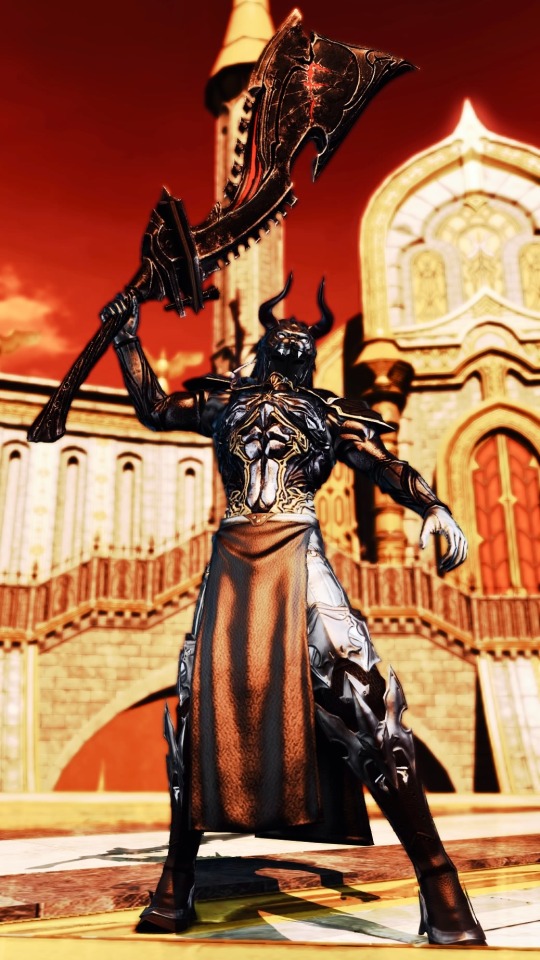
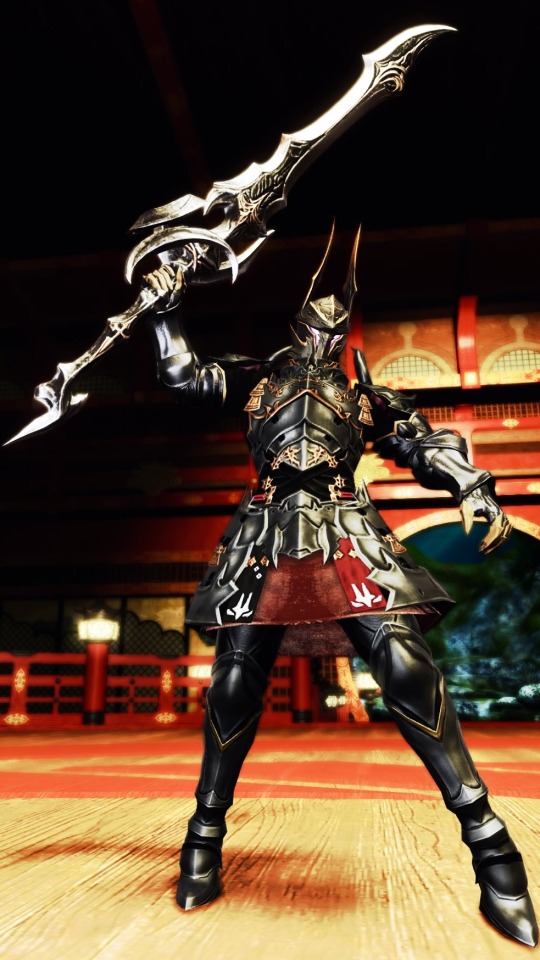

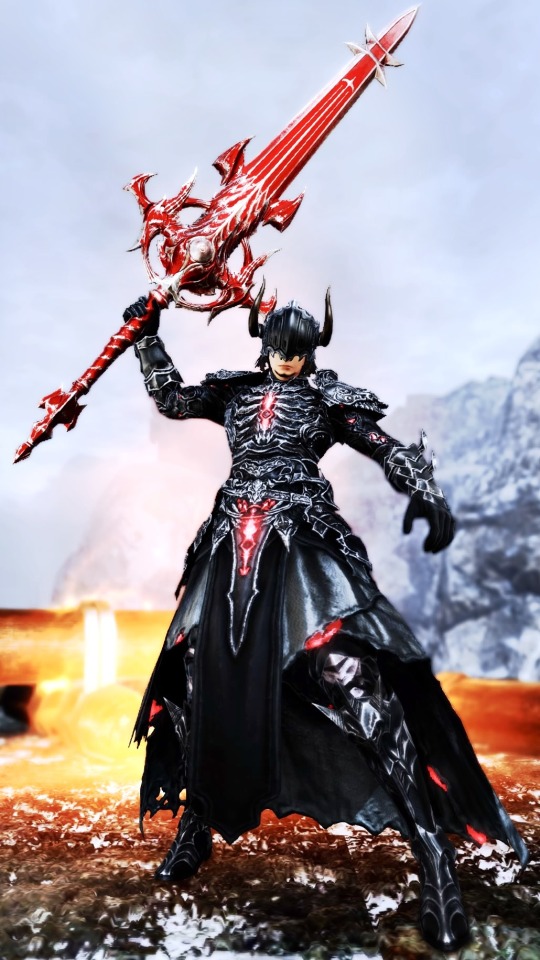

Decided to redo glamour progression for Maerec, my dark knight WoL! Edited/updated several of the designs. Explanations under the cut.
Focus isn’t on what is level/gear acquisition-accurate so much as what is tonally accurate. Going left to right, top to bottom. Sprout: Wanted to go with a simple, monochrome, Ishgardian-feeling look since my guy’s from there. Checked what armors are common in in the region as inspiration. Made a big point to give him a simpler sword here since story-wise Maerec’s supposed to start off as a run-of-the-mill mercenary. Wanted to hint at later style a bit but not to feel terribly noteworthy or impressive. This is his baby adventurer gear, I figure if he was thrown in with a group of newbies he shouldn’t feel super out of place. Paid attention to what early gear looks like in the game too and tried to weave that in. Worth noting, he has no helm/no horns. I find the angel/demon angle for Ascians versus mortals really interesting and decided to play into that with Maerec across his designs. End-A Realm Reborn: This is the one time I allowed myself to re-use a headpiece lol. Technically speaking I maybe should have used the Fray-helm with the Admantite Barbut of Fending since it would have been a fun lore bit and start the progression from no-horns/no headpiece into having something. Ultimately though, I just like the way the helm looks with that glamour too much not to use it and I think it has the exact tone I want generally speaking. Used a slim but more ornate sword than the first one, switched gloves and boots to be more visually cohesive in terms of patterns and metal. This was an easy choice as well because at this stage, even if overall costume design is getting a bit more elaborate for NPCs it’s still kind of blocky and simple overall. Beginning-Heavensward: I split Heavensward designs because to me, it felt necessary to transition toward more complex visuals. For the initial look, I went with a dual-finned Deepshadow helm as a quiet evocation of dragons and chose the top both because it’s not over-complicated and has some fur to offer a sense of being at least a little warmer. I figure since again, my guy is Ishgardian and this would be a time he’s actually going to the main city-state it fits for him to have more visual references to the Dragonsong War here. Silhouette is still generally consistent though. This was also the point I felt comfortable bringing in a big-ass sword. Went with Shadowbringer because it meshes with the metalwork.
End-Heavensward: Went much more complex for this point, and I get a lot of fun from being visually similar-but-not-identical to Dragoons. Mostly the same here but I used the PVP blade because I worked hard to get it, it goes, and I love it. I also think giving a bestial look here is fun given what’s ahead in Stormblood with Zenos. Stormblood: THIS WORKED OUT ASTOUNDINGLY WELL FOR HOW MUCH DIFFICULTY I HAD WITH IT. I have a bunch of Stormblood-inspired tank glamours overall, but the main look that would reflect Maerec specifically at that stage (in Othard or in Gyr Abania) took a fair amount of thought. I’d decided I did want to shift the open-faced glamour into Shadowbringers instead, and set my heart on the Diabolic Helm of Fending to shape the rest of this look around. That it meshed in spikes and color scheme/metallic accents with the Asuran Hara-ate of Fending was incredibly exciting! Also worth mentioning here, while Maerec’s overall color is black, the main accent color I want in-place for him is red for the full goth-y effect lol. It started creeping in for Heavensward but this is the stage when it really starts to show. Sword is still big but a little less bulky here compared to Heavensward too.
Shadowbringers: Face revealed here with horns, I feel like there’s fun to be had with the dark hero/villain duality and for adventures on the First decided to maintain the dark aesthetic but in a more open way to easier communicate heroic connotations visually. Red accents firmly established here with a look like embers. This point begins a visual callback to the long train in the ARR design.
Endwalker: Deathbringer is basically my favorite dark knight weapon for having the Azem symbol, but I decided to save it for this point since here is where we really know our role as the Shepherd of Stars/Sun/Traveler. This look continues the call-back to the ARR design started in ShB with the train, but now includes the helm too. The red accents are also much brighter at this stage, and the overall look has become much more ornate.
Azem: I finally decided what Maerec’s Azem would have looked like. Maerec is intended to feel a step off of Meteor, so I wanted to draw from something else in-game for his Azem. I have affection for the idea of Azeyma drawing influence from both Venat and our Azem, and I’ve been doing a lot with red in Maerec’s color scheme. So I decided to weave that in with his hair and eyes. Figure the beard was still there, but he once had luxurious flowing locks and more golden undertones to his skin. Facial structure is consistent.
#ffxiv#final fantasy xiv#final fantasy 14#endwalker#shadowbringers#stormblood#heavensward#a realm reborn#hyur#midlander#ffxiv screenshots#DRK
7 notes
·
View notes
Text
Improving Writing Style
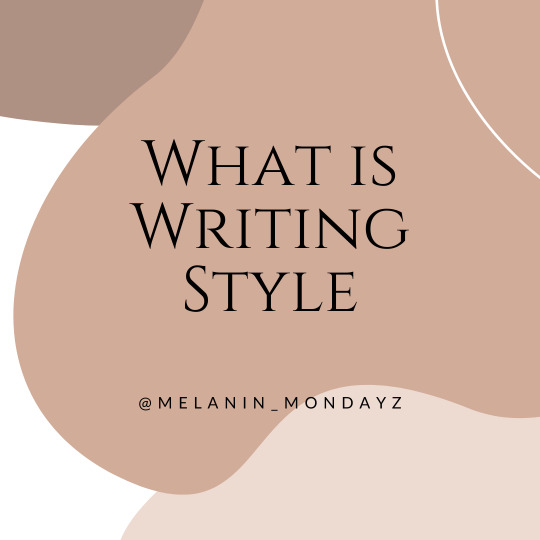
Our writing can be flat sometimes. It’s the worst thing that can happen to us. If the writer is bored, then the story is boring. We need to spice up the recipe. Once writers brush up on their writing style, they’ll find more motivation and inspiration. How the project reads and floats is what gives your story life. Writers have to roll out a red carpet before revealing their main character. Style is a complicated concept to learn. In school, I never covered these kinds of topics; instead, I looked through Youtube videos. After days of research, I’ve found 5 fundamentals that writers need to keep in mind.
Metaphors:
For me, metaphors are the most difficult parts of writing yet the most important. Metaphors connect us to the scene, the character, and even the villain. Readers will understand the situation more once you compare whatever it is you are writing about. But how do we do this?
“Maven is more desperate, surprising himself as much as me. He knows I’m sinking fast, a stone dropping through the river. And he wants to drown with me. Excerpt From: Victoria Aveyard. “Red Queen.” Apple Books.”
Mare is comparing herself to a stone. The connection points Victoria Aveyard makes are; 1.) She is sinking in her situation, 2.) she’s sinking into her steamy kiss with Maven, and 3.) the setting takes place near a river. Metaphors don’t always need 3 connection points, but the more power the connection, the more influential the metaphor. I’d also like to point out this example has a lot of the build-up to it, so don’t think you have to start this strong. The best place for a metaphor is when you’re facing an obstacle, or you’re trying to describe something the senses can’t capture. Yes, the sense could capture Mare’s kiss, but the metaphor gave it meaning.
Sensory:
I’m sure you know of the five senses, but can you work them into your writing. We sometimes forget readers can’t see what the writers see. They are a blank canvas ready to be splattered with the bright colors of paint. You shouldn’t overwhelm us with several senses but instead just explain two.
““I was just trying to watch the game.” Scarlett wrapped herself deeper into the curtains, but Legend pulled her away. His hand was as cold as snow, his youthful face concealed by a shadow. Frost nipped Scarlett’s naked shoulders. Legend laughed and wrapped both hands around her waist. “I didn’t invite you here to watch, precious.” His mouth moved closer to hers, as if he was about to kiss her. “I want you to play the game,” he whispered. Then he threw her off the balcony. Excerpt From: Stephanie Garber. “Caraval.” Apple Books.”
We see and feel what Scarlett is experiencing along with deceptive dialogue. Knowing how the scene looks and feels causes the audience to be sucked in. We feel the frost nipping at her shoulders. Next, we see Legend pull Scarlett out of the curtains. Finally, we experience the fall and fear Scarlett is witnessing.
Word choice:
Denotations vs connotations. Curiosity vs nosy. Denotation is the dictionary definition. Connotations have a different tone of the word. Nosy has a more negative depiction, and you would NOT use it if you were writing about Sherlock Holmes. ( Well, maybe you could)What you should focus on is your word choice. Keep in mind your sentences require clarity and simplicity. Don’t overload the reader with unnecessary words.
““Don’t touch me!” I jerk away, glaring, clutching the foot of his bed like it might be a weapon. “I should shoot you all over again for doing that to me! I should — I should — ” “What?” He laughs. “You’re going to throw another pillow at me?” I shove him hard, and when he doesn’t budge, I start throwing punches. I’m hitting his chest, his arms, his stomach, and his legs, anywhere I can reach, wishing more than ever that he weren’t able to absorb my power, that I could actually crush all the bones in his body and make him writhe in pain beneath my hands. Excerpt From: Tahereh Mafi. “Ignite Me.” Apple Books.”
Juliet is trying to fight her love interest, and from the sound of it, she’s angry. The words she uses to describe her movements make sense. We have a sense that she is fighting aggressively but failing at the same time.
Show vs Tell
Show me, don’t tell me your character is in pain. Instead, show me your character crying in the corner. The show sees your character using her power. This part of the writing style brings your story to life. Every writing professor emphasizes with this in their teaching. This fundamental is like adding frosting to the cake. In fiction, you have to show the scenes. Other than words, Readers have no other visual. This is how you experience the final battle or explain the first kiss. Show us.
“Her hands felt guided. She didn’t fully understand, nor was she completely in control. But she trusted. Kyoshi braced her stomach, filled her lungs, and slammed her feet into the Crowding Bridge stance. Echoes of power rippled from her movement, hundredfold iterations of herself stamping on the ice. She was somehow both leading and being led by an army of benders. A column of gray-stone seafloor exploded up from the surface of the ocean. It caught the hull of Tagaka’s cutter and listed the ship to the side, tearing wooden planks off the frame as easily as paper off a kite. Excerpt From: F. C. Yee & Michael Dante DiMartino. “Avatar, The Last Airbender: The Rise of Kyoshi (The Kyoshi Novels Book 1).” Apple Books.”
Kyoshi, the GOAT Avatar, is bending earth she can not see. From the words we are given we are able to see the picture of the earth bender using her extraordinary strength
Descriptions
Descriptions can make or break your story. Either you can set the scene, establish a problem, or overload readers with exposition. We have moments where we stop and absorb how the character looks and why the things the way things are in the description. I would try to avoid dialogue for as long as I can when writing these. Get your description out before or after the conversations.
“Principal Falcon has a bronze sculpture of a falcon on the edge of his desk. I stare at it, wondering if it’s the sole reason he became a principal. No other office would have held this sculpture so well. Maybe a government office, like Governor Falcon. I’m sitting between my mom and Olivia. My mom got dressed up and insisted that I dress up too. I didn’t, per se, but I’m not wearing sweats. She sits on my left in her attorney clothes — wide-legged black slacks that tie at the waist, silk white blouse tucked in, black pointed-toe stilettos. Her legs are crossed, the bottom foot bouncing. Excerpt From: Joya Goffney. “Excuse Me While I Ugly Cry.” Apple Books.”
This example Establishes the scene. We observe the thought process of the main character Quinn. It’s simple and to the point, paving the way for more dialogue. We learn how Quinn views her principle, how serious her mother can get, and how anxious she feels.
12 notes
·
View notes
Note
Ronan give the top ten heroes their own title challenge. Jk actually no, you don't gotta, but it's an interesting thing to think about. Just for funsies.
(In reference to this post)
Hahaha, yes! Let's try it out! (I'm not that creative though lol)

Endeavor: Flames of Rebirth/Perserverence
Spoke about it a little before, and I think the story can explain why I think this fits.
Hawks: Wings of Resolve
The guy flies because he made a commitment. Enough said.
Best Jeanist: Threads of Identity? Wishing Threads? 😅
He's very distinct about identity. Shows in how he conducts himself, and urges others to live up to how they present themselves. And of course, the two-sided heroes/villains coin and Bakugo's hero name being a wish.
Edgeshot: Ninja of Precision
He's very focused, and not just in how he fights. At the charts, he states his focus is only on delivering results and letting his work speak for itself.
Mirko: Zealous Moon Rabbit
I spent a while on her. Words have different connotations, so I was trying to find some that fit what I think her character is. I came up with zeal, earnest, deliberate, and voluntary to connect with how she's intent on having no regrets so she makes every moment of her life count. But then I read up on the lore behind the moon rabbit her moves and costume are inspired by:
The rabbit went all out in doing what it intended to do. Mirko also goes all out. So she regrets nothing by the time she checks out. Maybe Moon Rabbit by itself is a good title for her already.
Crust: Shield of Reverence
Because as over-the-top Crust was, everything he did was in respect of another person. He sympathized excessively with Ryukyu at the charts, but in respect of her grief. He seems to have a great respect for All Might. He highly regarded Mirko's prowess as a hero, I think, even if he went in to try and help her. It seemed like he had serious respect of her capabilities, but still went in regardless cause who doesn't need help sometimes? And when everything went to shit, he saved Aizawa out of aknowledgement for his essential role in the current situation. Goddammit, now I wanna write a oneshot character study as a tribute. Damn you, Horikoshi.
Kamui Woods: Budding Roots? Beginning Roots?
Rookie who continually strives to learn and get better. Lifelong learner could be his theme? Idk, he hasn't really solidified his heroic character yet, so can't really give him a title yet
Wash: idk
no. im not even gonna try. i have no idea what his freaking character is because i cant understand anything out of "WASHYWASHYWASHYWASHY--!"
Yoroi Musha: Sword of History
Tradition. History. Learning from the past. You get my flow. He's still kinda stubborn, though, which I don't like, but I do think he's pretty interesting if he's like a veteran with all this wisdom from the past. Didn't use the word "wisdom", though, because like Hawks said, he's still pretty inflexible. Man, I love that chapter. And Hawks.
Ryukyu: Dragon of Protection
She's motherly, period. Ryukyu cares a lot about the kids and the people around her, and she looks absolutely terrifying when she's about to rip someone's head off to protect someone. I love her character. I wanna see more of it.
I took this seriously, but at this point I'm not surprised because I'm me. Anything to do with analyzing will make me think seriously about it, especially in regards to characters. I'm really glad I got to explore each of the individuals in the top ten. Thanks, anon!
(Not Wash, though. Like, fuck that. I need something more out of you than just "WASHYWASHYWASHYWASHY--!")
#ronan answers#anon#character study#bnha#mha#endeavor#bnha hawks#best jeanist#edgeshot#mirko#miruko#shield hero: crust#whatever wash's moniker is#kamui woods#yoroi musha#ryukyu
33 notes
·
View notes
Text
What medium best expresses Sonic’s character?

Right, so this is a bit of a detour from the typical Hazbin Hotel posts I’ve been making, but I really did a heck-ton of work to come up with this. Then again, I type overly long paragraphs as a hobby, so jokes on anyone who thinks I don’t do this for fun... but then again... jokes on me for making the time to type Hamilton-esque essays on fictional characters ._.
Okay enough with tangents, this is an essay dedicated to answering what medium -- songs, scenes, cartoons, maybe even a comic issue -- best encompasses Sonic’s character. Take in mind, throughout the 29-almost-30 years of Sonic, there have been many iterations and takes on the character that either differentiate on a minor level, or to the point that some Sonics when compared seem to be starkly different characters altogether, so this is purely what I feel is the best take on Sonic’s character. For my sake, I’ve sworn off including material that require a long-winding read through some mediocre storylines -- nothing personal, Archie Comics. I won’t be covering Archie Comics because I’ve yet to finish reading all 200+ comic issues because that’s not humanly possible for me. If I ever manage to though, I might make a post about Archie Comics in some way. For now, here’s my personal essay on “What medium best expresses Sonic’s character”
Starting off with shows...
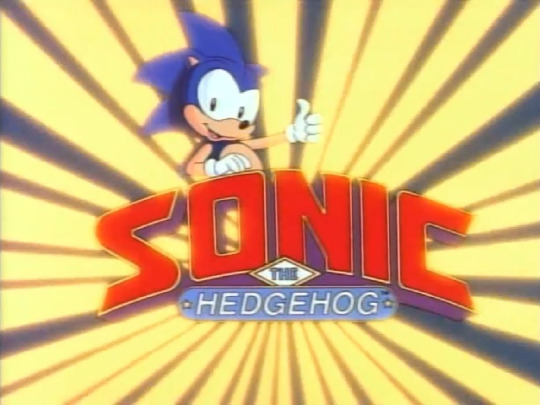
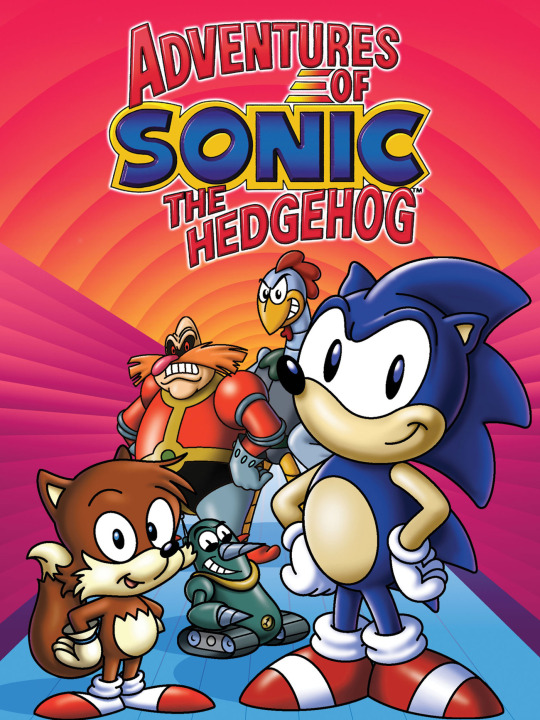
Sonic SatAM (1993) and Adventures of Sonic the Hedgehog (1993) are products of their time, and I never got to watch them when I was young, so I hold no sentimental nostalgia. Sonic SatAM seems in-line with Archie Comics, with the Freedom Fighters plotline and the infamous Sonic mohawk with lasted for a significant amount of issues. Adventures of Sonic the Hedgehog was pretty comical and lighthearted in comparison. Both were voiced by Jaleel White, had the same artstyle, and established Sonic’s character in vastly different tones. It’s rather outdated as Sonic has lived past the 90s for 20 years, where he got revised and reinvented to suit the decades. So both characterizations are simply inapplicable to Sonic’s character.

2003′s Sonic X worked off of the newly reinvented Sonic and paved way for Sonic’s personality for the following years, but I do have critique over the show, and their execution of Sonic’s character. Though they did provide Sonic's "constant desire to run", he lacked soul and the over-the- top nature of his character. Sonic throughout this show displayed a rather hollow connection with his relationships, was as distant and aloof as Knuckles for seemingly no reason, lacked much depth and barely developed, and was overall, very poor with communicating his thoughts and actions -- which ultimately led to a number of plot lines where his friends and/or authorities saw his intentions as malicious or even evil. Sonic is hyperactive and free-spirited -- something this show doesn't fail to display -- but Sonic lacked his heart. Where was that desire to hang out with his friends? Where was the underlying love and compassion he'd constantly display in and out of battle? Where were his cheesy yet well-meaning impromptu speeches? These aspects of Sonic were sorely lacking and missed when I watched through this series which is why I believe this anime didn’t really express Sonic's character.
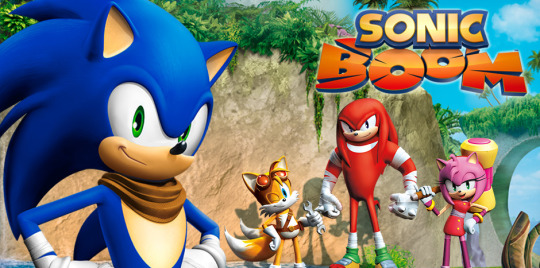
Sonic Boom...
...is a lighthearted, slapstick sitcom-based comedy. Very episodic, which is aight, but the the show’s execution as a whole was mediocre-borderline-bad. It doesn't have much elements inherently Sonic-esque -- it's a product of the Modern era, which at this point, doesn’t seem to have good connotations. No worthwhile soundtrack, stunted animation and movement, embarrassingly heavy reliance on overused archetypes/stereotypes at the expense of the characters, repetitive plots that get the THICC layer of frosted sarcasm and self-awareness. Sonic had attitude sure, there was a clear level of disinterest and cynicism to this portrayal -- it was as though protecting people felt like a burden and chore to him. It doesn’t help that this feeling is justified as Eggman’s been reduced to a pathetic Saturday Morning villain with lesser competency in being a world threat, and much rather a constant nuisance to Sonic’s town than anything else. Subjectively speaking, this show's clearly not for me -- even when I was in the supposed age range at the time. Objectively, this Saturday morning cartoon should've been branded as it is, rather than a Sonic cartoon because the identity of Sonic the Hedgehog definitely got skewed and misconstrued by the eyes of newcomers whose first exposure to Sonic the Hedgehog character was this. Ironically, due to this show, I subsequently furthered my distance from the franchise at that age, and got into it much, much later in life.
Now moving onto the songs...
Initially, I considered “Escape from the City”, “Live and Learn", "His World" and "Fist Bump" as good contenders in defining who Sonic is. But through some vigorous looping of those songs, I've pinpointed what they've to offer in showing Sonic's character, and due to my consistent nature of typing overly long arguments about anything I find interesting, I'll be putting each song into its own paragraph -- picking out any significant verses, and explaining why I think each song subconsciously contributed to my thought process that they would be the best take on his character. Afterwards, I’ll finish with my conclusion. (I personally suggest you go listen to each song as you read each paragraph)
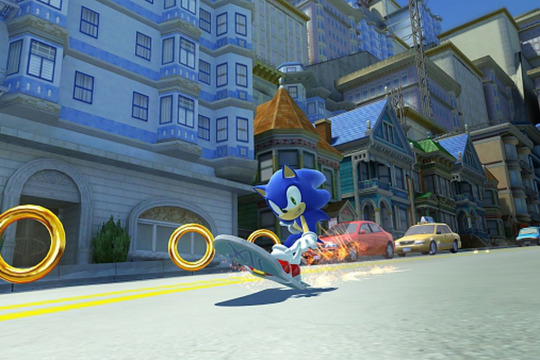
"Escape from the City" is a timeless bop, and I will play it in the car whenever I'm actively escaping from authorities in my city. What this song does is use rhythmic beats and repetitive bass line to emulate the constant adrenaline and excitement Sonic feels when he's moving around, it embodies his carefree nature and spontaneity to a T. It succeeds in portraying the energetic, upbeat aspect of his personality as the song itself contrasts the very dangerous implication of being chased down by the government for a crime you didn't commit. Sonic doesn't get enough credit for the amount of cheerful optimism he has -- always moving with a spring in his step, or steps considering the speed part. He brushes off the most life-threatening dangers he has to face and takes it all in with that well known Sonic™ grin. It also shares a constant message of "Live and Learn" (which the song of the same title) -- this is a rather succinct version of Sonic's mantra. The song is very Sonic, but only manages to show his surface level personality. Kinda like Sonic X's theme song "Gotta Go Fast" but it's much less in your face about Sonic's whole shtick. Another thing to note is the element of "escape" is a constant in both "Escape from the City" and "Endless Possibility", which I'll get further into later. Given that this song was more focused on the primary objective of ‘City Escape’ the game level rather than exploring Sonic’s fundamental character, it's very cool how it just so happened to tie in well with him...

"Live and Learn" was more of a Sonic and Shadow song, so I already kinda figured it wouldn't manage to explore Sonic's character much. The first verse and chorus offers as much for Sonic's character as Shadow's oh-so few lines of verse 2 does. Again, the song only manages to provide Sonic's surface level personality. Reason it came up in my mind was because of the words 'Live and Learn'. It's a very motivational and inspiring line -- what got me thinking about Sonic’s character in the first place. It's an unspoken rule for him to take life headfirst and live in the moment, and legit the second issue of the IDW's comics reiterates this by Amy expressing that this free-spirited approach to life is what essentially makes her love him.
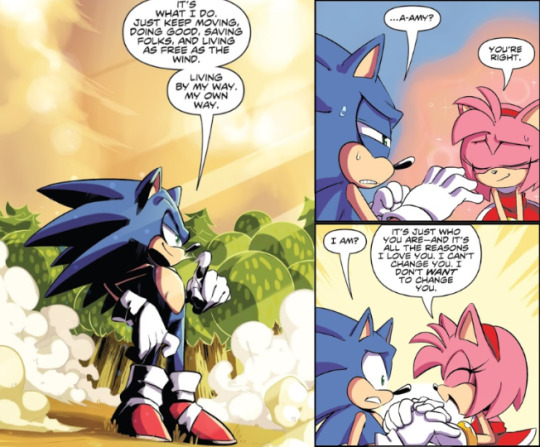
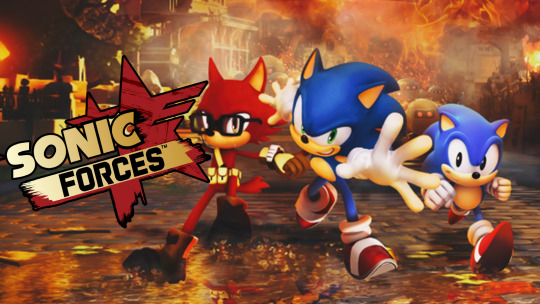
"Fist Bump" was like my first exposure to Sonic main theme songs -- and I'm still into listening to the song. I realize the lyrics are pretty generic, but it does reflect the general focus of Sonic character very well -- which may further explain why Modern Sonic is much less... developed, to say the least. What the lyrics essentially hone in on are Sonic's loyalty to his friends and his.... unyielding determination? Honestly, a very generic take for a main theme, and it reflects on the quality of the game if even the music lacked much personality compared to any heroic video game character theme song. Sonic had more personality to offer in his silent protagonist games, compared to this. This issue with Sonic's character barrels down to Modern Sonic retaining his previous counterpart's cheesy insistence to spout improvised speeches and embrace the power of friendship -- though it's definitely gotten out of hand in this case. We need balance.

Making Sonic more family-friendly ≠ Dumbing down what nuance or individuality there was to his character and making him every other generic hero protagonist who quips for 90% of his dialogues.
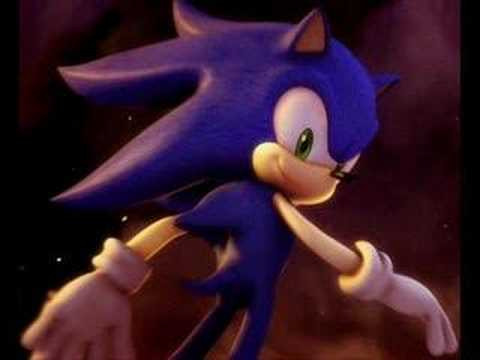
Finally, "His World", but I'll do Crush 40 and Zebrahead's separately, sort of. Crush 40 explicitly tells Sonic's character how it is -- his strict moral code, good intuition, confidence in himself, "seize the day" mentality, straightforward disposition, stubborn determination, love for his friends, and fearless risk-taking -- it's pretty lengthy but it does a good job as Sonic's theme and manages to state what it's like in his world. However, the song faces eerily similar issues to "Fist Bump" with it's lack of creative interpretation with its lyrics, and compared to "Escape from the City", it seems more formal and serious in tone which is reflective of their portrayal of Sonic.
I interpret Sonic as a multifaceted character, but when listing out all those traits in the verses and chorus in the song’s tone and format melody-and-lyric-wise, the song makes it appear as though Sonic is strictly a pillar of justice and represents the strong, untouchable hero persona -- which I find to be a detrimental writing aspect for his character. It writes off his personality as second priority to the reputation that would have receded him through the years of defeating Eggman and saving the world -- and subsequently, paints his character in a rather dulled and overly no-nonsense light. Not saying I don't want Sonic to be serious at certain points, but I think with this song, and this game as a whole, there was some truth to the issue of Sonic '06 being a little too serious. While these characters were well-written in this game e̶x̶c̶e̶p̶t̶ ̶t̶h̶e̶ ̶t̶h̶i̶r̶d̶ ̶p̶o̶i̶n̶t, I've had personal issues tied to em:
Shadow coming back was quite risky and foolhardy for his character journey and I believe if it weren't for the great execution for his storyline in '06, his appearance would've been viewed as fanservice -- which is what he's sadly been reduced to now
Silver's character concept as a whole was pretty dark and serious, which again isn’t a bad thing, but with the plot resulting in him seeing Sonic as the Iblis Trigger, it limited Sonic's ability to play up his easy-going, carefree nature since he couldn’t just brush off that accusation with offhanded remarks as that would’ve risked Sonic coming off as insensitive and unsympathetic at that moment. Which is not what the writers want their characters to go.
Elise. There, I said it.
On top of it all, "His World" is pretty slow-going for Sonic’s theme, which I could try justifying by saying it might’ve been a representation of significant growth to Sonic's character -- perhaps the journey managed to shape him into a man (hedgehog) who could spare a bit of time to contemplate his next course of action -- as this game definitely explored a major deviation from typical Sonic game story lines. But, even with that, I still really prefer Zebrahead's version.
Zebrahead's is vastly the same when telling Sonic's character how it is, but the instrumentals, pacing and speed is increased significantly that it definitely sounds more reminiscent of Sonic's musical style -- fast-paced rock and roll. But, I’ve yet to figure out the significance of the lyrics:

Especially when it follows right after "Never fear the fall" -- so you take the leap of faith, but also don't let yourself fall in the process? Pretty weird flow of words there, but maybe I’m just not getting it at all. Point is, what both songs hone in on is Sonic's intuitive sense of justice and a bit of his carefree nature -- since the lyrics from Zebrahead's specifically highlight on Sonic's "leap before looking" nature. What Zebrahead further hones in on is his adventurous and hyperactive qualities as verse 1 and the bridge show. It's a timeless song of anticipation and build-up with good execution, but it doesn't cover the main essentials in what makes Sonic Sonic.
Finally, reaching the song I've found best covers the basics and essentials to Sonic's character is...
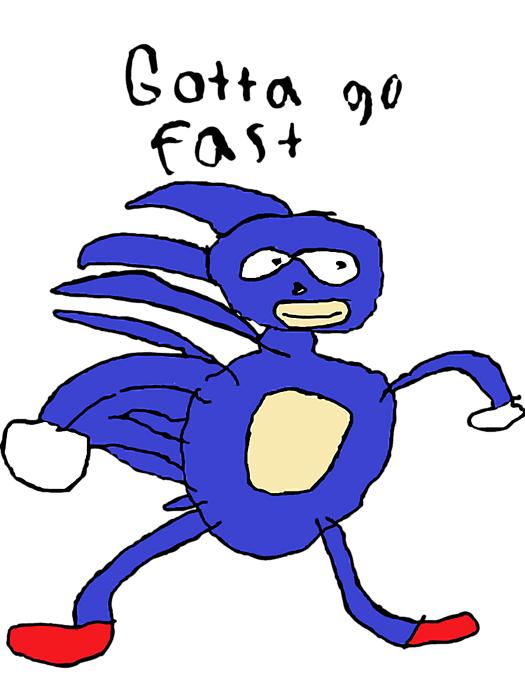
Believe it or not, “Gotta go fast” encompasses the defining characteristics of a well-written Sonic -- the title itself is a testament to the his motto and is all things Sonic stands for.

While this refers directly to the plot of the show itself, it manages to familiarize us with the speed and urgency crucial to Sonic’s character and--

Okay, clown time’s over, here’s the real winner.

Unleashed's main theme: "Endless Possibility"
From the get-go, intro already separates itself from the other songs by being freeing and exciting, without being too carefree like "Escape from the City", too orchestral or urgent like "His World", and definitely more compelling lyric-wise compared to "Fist Bump". This tone is a constant throughout the song, and makes it seem like Sonic's the one directly singing -- the singer nailed it with the level of obnoxious and genuine tone to his voice.
This song, like the rest of the other main themes, reflect the game itself. Unleashed is a race against time for Sonic to fight Dark Gaia before the Earth gets torn apart. But similar to the gameplay and form of story, the music is very fast-paced yet unburdening, with hints of inner contemplation, and darkness (or how I like to put it, edge). The first verse already succeeds in getting into the bare bones of Sonic's character -- he runs, he can never stay still out because he knows that's not who he is, he's free-spirited and will run around the world out of his own volition, it's a form of escape and liberty to him -- and this is what ties into "Escape from the City”. This verse sums up the essential traits to Sonic better than any of the previous songs without letting one attribute overpower it. It refers to his three fundamental traits: that he's fast, adventurous and carefree.
The pre-chorus further expands from verse 1's establishments, by showing the deeper, inner turmoil that pass through Sonic's mind -- “How will I know when I get there? And how will I know when to leave?” -- these are the rare instances where Sonic is found in inner conflict with himself which came out of his simplistic philosophy rather than an external conflict or influence, and it's more of unspoken and nuanced as Sonic never usually calls himself into question for the way he lives. This showcases that he's capable of processing the long-term effects of living and moving around aimlessly -- constant adventure and freedom might eventually feel mundane, so he might eventually find the destination his heart feels is right for him, so what will he do when that period of his life unfolds, and will this period end the days of adventure and freedom? The possibilities are never-ending, so as always, he'll take everything in stride, and prepare for whatever hits him.
This is what the song's main theme is. Endless possibility. Potential and growth -- which reflects back to Sonic: mentally, physically and emotionally. Mentally, he's acknowledged that he's always growing and developing throughout his adventures -- as there's one thing that no one, not even Sonic can outrun, and that's change. "Endless Possibility" opens us up to the concept of ever-changing development for Sonic, and the possibility that he might eventually reach his unknown destination and end this long-running journey, while also implying that every journey that he goes through and ends -- whether it directly ties into the games or off-screen adventures -- will always lead with a new one. Unleashed encompasses this youthful feeling of change and vigor. Sonic is in his element and is going through a personal journey to save the world once again, but as always, he'll do it with enthusiasm and unbridled drive.
Interestingly, Unleashed feels reminiscent of Sonic X's Sonic but done right. Both have the character mostly isolated from his friends for the majority of their respective stories, but where Sonic X forces Sonic to clean up on Isle Eggbot each episode, Unleashed puts him through a singular adventure that requires he takes care of the major issue at stake while the others are doing their respective jobs or living their own lives. Unleashed's Sonic even has a temporary companion which he clearly warms up to and befriends throughout the whole journey, whereas Sonic X shows Sonic actively dismissing his previous friends to sleep, travel, and adventure for the heck of it -- while they spent a majority of the first season trying to find the chaos emeralds without him.
Sonic being isolated is usually due to situational happenstance rather than conscious preference. Sonic isn't inherently solitary or aloof, it's just due to his ability to move from place to place with ease that he subsequently has to leave his friends behind to confront the source of the problem. It's not a part of his character that he plays lone wolf like those archetypal "cool characters", the nature of what he does and excels at leads him to fight front and center, even if it means doing it alone. Despite this, he still is the sentimental, over-the-top dork that believes in the power of friendship and will go to the ends of the Earth to protect his friends. Which is exactly what he does in Unleashed.
The bridge provides the hints of edge where Eggman and Sonic exchange dialogue in the song, very much referring to the events of Unleashed's intro battle between the two. Eggman essentially tells Sonic to give up as he's actually beaten him -- which Sonic replies that it's not over, that this is just another start to another journey. The lyrics aren't very subtle about what they're saying, but it does a good job in encompassing two key traits when Sonic responds to any threats -- his cheerful optimism and unyielding determination. He doesn't respond to danger with simply quips, he responds to it with a campy but genuine declaration of strength and courage. The cheesiness in his words are very prominent, but he says them with a straight face like he's announcing his battle cry and promise to do what it takes to save the world and protect the ones he love.
In short, "Endless Possibilty" manages to fully encompass the best iteration of Sonic, and humanizes him to the point that I can only really see this as the current best sum up of his character without any needed dialogue, animation, or prior context. This song could just be tied directly to Sonic's overall character outside of the game's plot, and I'd be fine.
#my posts#sonic the hedgehog#sonic#sonic character essay#my character essays#small spoilers for idw#another session of overly long essays from yours truly
18 notes
·
View notes
Text
Writers’ Weekends Lesson 2.
Welcome to the second class in our Writers’ Weekends series.
Lesson 2. Plot Beats
What do we mean when we talk about story structure?
A story is a complex thing comprised of many interconnected parts. To turn those pieces into a narrative, some sort of organising principle must be imposed by the author. The result of the organising of the material is the story structure.
Certain structural markers are obvious to the audience, such as chapters in novels. Elizabethan plays are typically divided into five acts. A film script is broken down into acts, sequences, and scenes.
The beat is the smallest unit of story, below the scene in the structural hierarchy. It is the space between an action and the reaction it causes within a scene.
Beat
Scene
Sequence
Act
Story
Scenes and acts are defined in screenplays, like chapters in novels. But stories have structures that are not usually made obvious or explicit.
This lesson’s focus is on setting out the bare bones you are going to going to hang the flesh of the story on. For the purposes of this lesson, I will be talking about stories that follow a three-act structure.
In screenwriting, it is often called “beating out” the story because you are making sure your story hits the key beats in a three-act structure required to be psychologically satisfying to your audience. The beats have various names depending on which text you read (looking at you “Save the cat”) but ultimately it doesn’t matter what you call them - so long as they are there!
The key beats you should have for a story to feel complete are:
1. Opening image and The Set-up.
In screenwriting, we always like to have a super-strong “opening image” that sticks in the mind and looks great in the trailer, but in terms of fanfic, I say it is important to weave a really vivid image into that first chapter so it sticks in the mind of the reader - enough so they will click into the next chapter, or hit follow. It is often an image that relates to the tone of the story and might provide a “snapshot” of the problem the protagonist will face once the adventure begins.
The other part of this beat is The Set-Up (sometimes called “The world at rest”), and it establishes for the reader the general world and situation of the protagonist before the events of the story enact change. This beat will often (but not always) include some iteration of the story’s central theme to the protagonist, who as yet unchanged by the coming story does not understand or accept it.
2. Inciting incident or Catalyst
The moment where life as it is changes. This is the point in your piece where the events of the story begin to change for your protagonist. It is the visit from Hagrid saying “you’re a wizard Harry”, It is allowing the killer into the house to use the phone, or meeting the true love of your life or discovering the body of a missing person etc. The “before” world is no more, change is underway.
3. First act turning point and Break into Two.
Some people separate these as two distinct beats and you are more than welcome to do that if it makes your planning easier. I tend to find in my writing the first feeds pretty naturally into the second so I tend to beat them together.
The first act turning point is the beat in which your protagonist debates which way to go in reaction to the inciting incident. It is the moment for the protagonist to choose a course of action the consequences of which will play out through the rest of the tale.
For example, if the inciting incident was the bombing of Pearl Harbour the turning point might be the protagonist debating whether or not to enlist in the army and leave their family or not.
The Break into Two (meaning Act Two) is when having made the choice we see it go into motion.
So again using the above example, having decided to enlist, the protagonist says goodbye to his family and leaves for Boot Camp. It is where the protagonist leaves behind the world of The Set-up and enters the unknown world of Act Two.
4. Subplot and B story
This beat is not always included as key, but I like to use it as a check-in point for myself.
A common complaint about subplots - especially romantic subplots - is that they feel shoe-horned in or tacked on. This is because they are too often added without thought for how they prove (or disprove) your premise (see lesson 1.) Every scene, every sentence, every bit of dialogue should serve to illustrate the premise of your tale. It is a common error to write the romantic elements as a completely unrelated thread to the main thrust of the plot.
To avoid that, I use this beat as a palate cleanser. It gives your reader a moment to switch gears between the world of the first act and the coming onslaught of action in Act Two.
It often manifests as a discussion which features the theme of the story – the central nugget of truth. Usually, this discussion is between the main character and the love interest. It is often the moment you look back on in a movie or series as “the moment” the two characters begin to see one another differently or even start to fall in love. Obviously, it need not have romantic connotations. Say if your premise is about family bonds, this moment might be a reunion of a father and son through shared labour building a fence etc. but its purpose is the same.
5. The Plot in Motion. (Sometimes called The promise of the premise)
This is where you get into the meaty, juicy part of your plot! Fun! It is where your detective will find the most clues or your action hero will dodge the most bullets. The protagonist is fully engaged with the changing world and the audience will be entertained by the events the protagonist encounters so long as they deliver on the premise.
6. Midpoint
The middle point of any story is (almost always) one of two extremes.
Everything is “great” or everything is “awful”.
The main character either gets everything they think they want (“great”) or doesn’t get what they think they want at all (“awful”). But not everything we think we want is what we actually need in the end. (E.g. The heroine wants the promotion overseas, it isn’t until she has it she realises what she needs is the support of her small hometown community and the love of the boy next door.)
Generally, the tone of your intended ending will indicate which option you are looking for here. If you are writing a romantic comedy with a happy ending, for example, this is the moment your heroine has a fight with her date, goes back to the office and due to her upset, blows her presentation to the Boss and then goes home to find her beloved dog has gotten out of the yard and run away. The remainder of the story is the climb back. However, if you are writing a tragedy this is the moment when victory is so close and everything is wine and roses and the remainder of the story is the protagonist’s fall into darkness.
7. Second Act Turning point.
The forces of the villain and/or antagonist begins to be brought to bear. Physical and emotional obstacles appear to defeat the main character’s goal, and the main character’s “great”/“awful” situation disintegrates. They face a second choice in course of action, the consequences of which have high stakes and drive the story forward into the final act.
8. Break into Three
Thanks to a fresh idea, new inspiration, or last-minute Thematic advice from the B Story (usually the love interest), the main character chooses to try again.
9. Climax or Finale
The villain and protagonist meet head-on (figuratively or literally depending on genre). This time around, the main character incorporates the lessons they have learned throughout the story. Having gained insight and strength from discovering the truth of the premise their fight for the goal is a more even and winnable fight because they have experience from the main plot and context from the subplot
10. The New World (Sometimes called Epilogue State) and Final Image.
This is the symmetrical beat which opposes where we began. It shows the world and the protagonist in their new state of normal, changed by the events of the story. It does not need to be a literal epilogue it can just be the closing paragraphs of a tale which gives the audience a sense of the future that awaits our protagonist and cast of characters. It closes the loop of your story and creates a sense of balance and continuity.
The final image is your last chance to leave something imprinted on the mind of your audience.
It’s Thelma and Louise driving off the edge of the cliff or the “What’s in the box?” ending of Se7en.
It is a well-accepted truth of screenwriting that audiences go away remembering the first few minutes of a film and the final few minutes of a film and that those “hooks” are what they tell other potential viewers about. I think this is similar to the way people discuss fanfic - you can’t necessarily differentiate by characters so saying “The one where Hermione hits Bellatrix with a blood-boiling hex” etc. is common. Giving your audience a couple of memorable images will help with expanding the ability of people to find your work when it is recommended.
SUGGESTED TASKS FOR LESSON TWO.
Write a sentence or two for each of the key beats of your story.
Be firm with yourself, don’t try and cram in too much plot. This is just a signpost for each KEY beat. We don’t need every bit of plot or story yet.
1 note
·
View note
Text
Supernatural 14x14, Ouroboros -- Overall Thoughts
Here we have Supernatural 14x14, Ouroboros. And just wow, what an episode! It's been a while this season since I've had an episode that just left me feeling...well, good about it. This season hasn't been bad by any means, it's just been very uneven. A lot of the episodes in Season 14 have been while not bad, they've more been just "okay" episodes, episodes that are just kind of there. But this episode I had a lot of fun with, it was great.
Just an FYI, I may get into spoilers here so if you haven't seen the episode, maybe skip this. But really, here I'm just going to be talking about the theme of Ouroboros and what it meant to the characters in a general sense.
So Supernatural, 14x14, Ouroboros and what an "on the nose" title this is. So many visual and not-visual representations of a snake biting itself. And that's basically what the Ouroboros is in a more general sense. Our decisions causing us to reap consequences that in a meta-physical sense essentially causes us to bite ourselves. We have the gorgon with the whole cannibalism angle but also, its ego was its own undoing. It sent a note to Dean, you know in typical serial killer fashion, but in so doing, it gave away the fact that it can't see Cas or Jack when it looks into the future. By TFW2.0 realizing this, they were able to get to the Gorgon before it could escape and kill it using the knowledge that it can't see Cas or Jack coming. Its own ego lead to its demise so essentially the gorgon biting itself. Then we have the whole aspect of TFW2.0 and au!Michael. They nixed the coffin plan in favor of finding something else. But the consequence was that when Dean losses consciousness in this episode, he lost the ability to keep au!Michael trapped so their own decision caused this consequence. Them biting themselves in a sense. Au!Michael kills all of the hunters in the bunker (which by the way, I called that way earlier this season that was probably going to happen) but these are the hunters they brought back from apocalypse world so essentially, in a meta-physical sense, they're a part of the Winchesters. The Winchester's decision lead to these hunters being killed thus the ouroboros. The decision lead to Jack burning off his soul so there's an ouroboros there as a result of the decision to not go with the coffin idea. Jack was able to kill au!Michael but it's also taken away something he maybe didn't want to lose. Au! Michael essentially bit himself in the tail because he basically groomed Jack into being able to kill him. Everything au!Michael has done to Jack has culminated to the point of Jack finally killing him. It's also a villain trope as well. Instead of killing the hero when you have the chance, you let them live and then by doing that the hero eventually kills you. And in a way, there was also Rowena talking to au!Michael about how he can't kill her because she knows her fate is to be killed by Sam. Which lead to him saying the one thing he knew she wouldn't be able to refuse...so she essentially bit herself in that. But there’s also another aspect of ouroboros as well. That being the snake eating itself eternally. Basically, the same thing happening continuously. And that’s very interesting in the context of this episode’s consequences being so cyclical. Going on that hunt in the first place which lead to Jack burning off some of his soul to save Cas, the Winchester way of doing things -- sacrificing for your family, and then lead to Rowena sacrificing herself to save everyone, and then Jack sacrificing to save everyone once again. Which really, this all stems from the effect the Winchesters have on the people they meet. They inspire this sort of behaviour in others as well as themselves so they’re continuously moving in that circle of that snake eating itself eternally. It just continuously keeps going round and round and round. There’s also the literal aspect of Jack being the son of Lucifer and Lucifer has religious connotations to snakes. Especially since this episode had a lot to do with Jack and his sacrifice. Jack just continuously biting himself throughout the story and until he eventually sheds that skin (like a snake) and becomes a new beginning...and you know, eating the thing that basically made him what he is.
But moving away from the ouroboros theme real quick, I am wondering if Sam killing Rowena is still her fate. We were told her fate in Season 13, that was before the au folks crossed over. These people, at least I don't think that's how it works, were not a part of original SPN universe's fate. So when they crossed over, they're affectively changing the fabric of fate in this universe. How do we know that they haven't already changed Rowena's fate? Just a casual thought I had, there.
I'm also wondering why au!Michael's grace was enough to restore Jack into being a nephilim again. My own personal theory is that when he killed Lucifer both in the main universe and Apocalypse universe, he absorbed Lucifer's grace in both instances so that's why Jack was able to bring back his old self...hmm, another ouroboros theme there if you're going to take the literal eating yourself interpretation of it.
But ultimately, I'd give this episode an A-. I thought it was a very enjoyable episode. The theme was interlaced pretty perfectly. It was great.
Hopefully, you all understood what I was trying to say in this. I'm writing this as I'm coming off of a dose of nyquil so my mind is a little groggy and cloudy right now. To me, it makes perfect sense but to others, I'm sure you're all like, "what is this mess?"
Also tagging @metafest in case any one there wants to talk about this.
37 notes
·
View notes
Text
Dumbo Movie Review

If there’s one thing Tim Burton reliably does, it’s go big; going home isn’t even on his list of options. His movies are visual spectaculars, and if they sometimes lack genuine heart, they never lack things to look at. Disney’s Dumbo remake is no exception. Every moment of the movie is jam-packed with creativity, some of which is lifted from the original and some which is new to this version. Amid the splendor, the mute title character is instantly and unfailingly engaging, giving the movie the very spark many Burton movies need.
The plot you probably know, though the original Dumbo is no longer as widely seen as some other Disney animated movies. Dumbo is born with huge ears that allow him to fly, but when his mother attacks a cruel animal tamer for abusing him, she is declared mad. The original was just over an hour long, and this one has been expanded. Timothy Q. Mouse has been replaced by two children (Nico Parker and FInley Hobbins), who discover Dumbo’s talent when a feather makes him sneeze himself right into the air. They are of course not immediately believed by their father (Colin Farrell), who lost an arm in World War I and his wife to influenza and is determined to raise his children to be practical survivors. The owner of the circus (Danny DeVito) is a decent man at heart whose obsession with the bottom line is due to needing to keep himself and his crew fed. To this end, the movie adds an entire second half in which he makes a deal with a wealthy amusement park magnate (Michael Keaton) to feature Dumbo as his star attraction; also involved is the magnate’s arm candy, a glamorous French trapeze artist played by Eva Green. Alan Arkin has a small, welcome role as a banker the magnate is interested in wooing.
Dumbo is mute. To give him a voice would have surely been possible, and would not only have broken the fragile spell he cast in the original but the idea that he is, ultimately, an animal. That is accomplished here through CGi that is indistinguishable from the real thing. When Dumbo is sad, it doesn’t feel like a cartoon character moping, and when his mother goes on a protective rampage, it almost makes you want to back up in your seat. What matters more than realism, though, is emotion. Burton, screenwriter Ehren Kruger and their army of computer wizards manage to make Dumbo a believably deep character with real feelings. Classic scenes are recreated, including Dumbo’s embarrassing stint as a clown and a brief snippet of the still-glorious Pink Elephants scene. In the former, Dumbo’s sadness at his situation is palpable, and in the latter he is given a childlike wonder that could make a grown man’s eyes instantly turn into hearts. When he is imperiled, I held my breath just a little, and when he escapes by soaring free, I found I forgot for a moment that I am a critic and expected to be a cynical bastard.

That there was going to be a villain in this remake was inevitable, and going in I steeled myself at the thought; I didn’t feel the story required one. That’s still true, but what the filmmakers and Keaton have come up with is not lazy. I can sum it up in three words: Evil Walt Disney. The character, wonderfully named V.A. Vandevere, comes to Dumbo’s circus promising the impresario he will show him the future. This is 1919, and Vandevere’s future is a massive amusement park called Dreamworld complete with animatronics, flashing lights everywhere, a parade down Main Street, and even plush Dumbo dolls on sale that look like they could have been shipped over directly from the endless shops littering the real-life park. The parallels are so incredibly obvious I’m amazed the company, famously over-protective of Disney’s image, let the movie get away with it. Vandevere’s speeches about the future sound eerily like those Disney himself made on his television appearances; the fact he is cash-poor seems a low-key nod at the way Disney would go into debt in pursuit of a movie; and his ruthlessness at getting what he wants no matter who gets hurt is of course very similar to the criticisms leveled against the modern, post-Walt company. Burton and company did everything short of pinning a Mouse Ear hat to his head. The fact that Dumbo and his friends win in the end is the only aspect that doesn’t feel parallel to reality.
The 1940’s were a much more permissive time in the movies. Dumbo no longer becomes accidentally drunk, and the chorus line of crows has been removed, likely because of racial connotations. Instead, the human characters have been emphasized, whereas they were entirely unimportant before. I’ve heard criticisms that they are more important than Dumbo, but I didn’t find that to be the case; Dumbo is present and has an independent personality in nearly every scene, and is never a prop. The human characters succeed or fail on their own, and it is a mix of both. Farrell’s disabled war veteran is an inspired inclusion that roots the film firmly in its 1919 setting, as opposed to the general “anytime” of the original. DeVito’s impresario is the kind of genial loudmouth he’s so good at playing, and underneath all the bluster he genuinely cares for his performers. Green’s cynical acrobat isn’t a role that really uses her talents, but it’s always good to see her in anything. The child actors, sadly, are given rather wooden characters compared to the rascally and mischievous mouse, and bringing in all the carnival performers for the big finale is unnecessary and feels tacked on, since they’re never developed. Fortunately, Dumbo and his mom are always center stage, so these are minor issues.
Before my showing of Dumbo, I saw a trailer for the completely unnecessary remake of Aladdin, and it sucked the life right out of me. Dumbo handed it right back, and though it may not be the most inspired act in Disney’s remake circus, there’s a joy and a heart here, and that’s enough for me.
Verdict: Recommended
Note: I don’t use stars, but here are my possible verdicts.
Must-See
Highly Recommended
Recommended
Average
Not Recommended
Avoid like the Plague
You can follow Ryan's reviews on Facebook here:
https://www.facebook.com/ryanmeftmovies/
Or his tweets here:
https://twitter.com/RyanmEft
All images are property of the people what own the movie.
#Disney#dumbo#Michael Keaton#movies#Tim Burton#eva green#danny devito#nico parker#finley hobbins#alan arkin#ehren kruger
2 notes
·
View notes
Text

Photography, film and print are the main mediums I currently use to create my work. On the course I have realised my great interest in isolation within artwork, whether that is visual, physical or conceptual. I have grown to love exploring the result of abstracting something known, to transform its meaning into something much larger than what its physical shape represents. For example, during the work in progress show I researched the Japanese tradition that deals with failure and breakage, called Kintsugi[1], which celebrates a moment of failure, and highlights that moment as being of great beauty. Broken china is repaired with a special fixative that is mixed with gold, memorialising that moment in time in which it was broken. From this tradition I came to produce a series of images in which I photographed parts of broken pots in a way that made it incredibly difficult for the viewer to recognise what they were viewing, and therefore had no way of entirely rationalising the image. I became fascinated as to how the photographs appeared to capture a vast landscape, something immensely strong and unmovable, worn away and transformed by time, but as nature this is never something to be viewed in a negative light, unlike how we so often view our own breakages, and our own failures.
‘The individual it hails is intensely personalized and thus abstracted from the social world, but also lifted out of language and thus without a name’
[2]
Professor of film and television Sean Cubitt, addresses a fundamental aspect of isolation; the effect of taking something out of its context, like the broken pot for example, gives it immense freedom. It is transformed into something beyond its own physical properties, and thus placed under speculation and wonder from its viewers.
[1] Alan K. Ota, The New York Times Archives, (September 22, 1985) P. 002006, https://www.nytimes.com/1985/09/22/travel/shopper-s-world-japan-s-ancient-art-of-lacquerware.html
[2] Shaun Cubitt, The Cinema Effect, The MIT Press, London, 2004, p.10

I feel that New York photographer Saul Leiter’s work explores this isolation, and so greatly inspired this series of photographs, for his ability to abstract such a visually iconic location as New York City. The abstraction controls each photograph, transforming the outside world into a different kind of reality, yet there is always something in the photograph to ground the viewer, either a pedestrian or a traffic light, which acknowledges the real word. Yet, nearly 80% of each photograph is abstracted; the ordinary becomes the extraordinary, something less explainable, encouraging the viewer to look closer, to find wonder in the image, and therefore hopefully in the world around them. For example, this photograph by Saul Leiter, like many of his photographs, has a collage effect. This particular photograph was taken from outside one frame and simultaneously moves into another. Here the viewer is invited to look inside. The door handle to the car window is visible, like an invitation to an opening. The figure is unaware of the photograph being taken, and the viewer is allowed to observe, like in a travelling car, where one is able to see the movement of the world around you, yet you are distanced from it, and therefore become the onlooker. I feel like Saul Leiter’s photographs of New York City beautifully encapsulate the passing of time, and the wonder of observing the world around you, as they have the ability to take you out of reality, and so you are able to look at it in new ways.
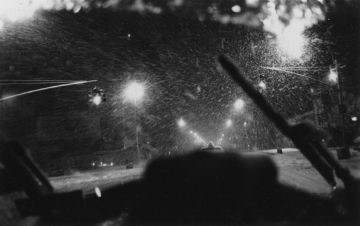
From this I became fascinated about a frame’s ability to acknowledge personability. The connotations of a window often suggest an opening, a connection, but at the same time they create a distance, a separation, a frame from which to see the world. The silence of a car, and the peaceful nature of movement allows for greater observation. David Bradfords book Drive By Shootings beautifully reflect this personal nature of observation through a car. The hand that appears within the frame evokes empathy, the viewer feels as though they are looking through the eyes of the photographer themselves. Thus, whilst the viewer is viewing the outside world from within, they are transcended into the photographers vision, their being, the viewer becomes physically involved in the photograph. Without the frame of the window screen wipers and the hand, the photograph would arguably evoke entirely different emotions from the viewer. The frame is no longer restricted to the physical object incasing the photograph, but is within the photograph, transforming how we see.

After taking a series of photographs whilst travelling in a car, I decided to explore the imagery of moving frames from the perspective of a commuter, for example the window on a train. I used acetate because of its transparent qualities, and scraped ink across in a sliding motion to emulate the passing of the outer world across the window of a train. From this experimentation I then decided to scan the images, one of which is the image you see above, which I found reflected the vision I had in a better way, because the viewer became focused on the shapes of the ink, rather than the texture of the acetate. I would like to explore the layering of frames in my FMP, and possibly investigate the result of casting light through the frames, to see if this transforms their energy.
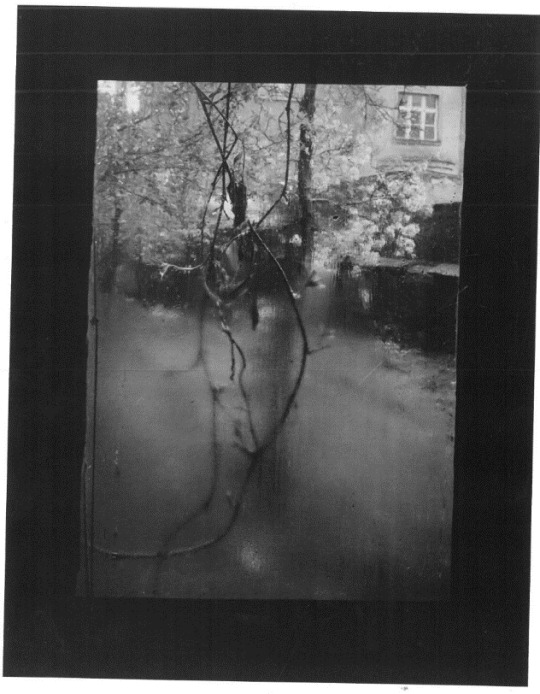
I have become more interested in the relationship between a window and its frame, and how the process of photography and film transcends the ‘literal and imagined division between inside and outside’ and how this is ‘re-enacted when the photographer looks through the lens and sees the image.’[1] What Karen Hellman implies from this is that by examining something through a frame, whether that be a figure walking by, or a landscape passing on a train, the space between the frame and what it is composing is removed, the frame in many ways literally captures its subject, allowing the viewer to silence anything that lies outside of the frame, and focus with greater clarity all that lies within the frame. Josef Sudek’s photograph, from is series of The Window of my Studio, is particularly interesting to me because it presents a frame within a frame. The frame of the window is framed by the photograph, which adds to its isolation. The darkness of the black frame brings the viewer closer to the light of the window, and the fog on the window pane deconstructs the space between the garden outside and the physical glass. I wanted to explore this further and felt that by using the medium of print, I could reflect the window’s capacity to act as a frame for abstraction, and so my creating my own frame through the contrast of black ink on white paper I could explore the connotations of windows further, and how the suggestion of a window can add layer to an image. I would like to look further into Sudek’s work to explore his use of double framing, as I would like to incorporate this into my FMP work.
[1] Karen Hellman, The Window in Photographs,
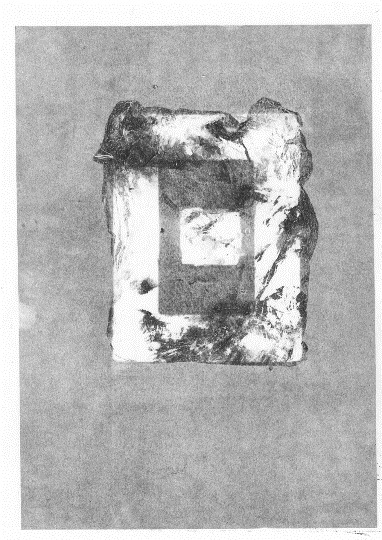
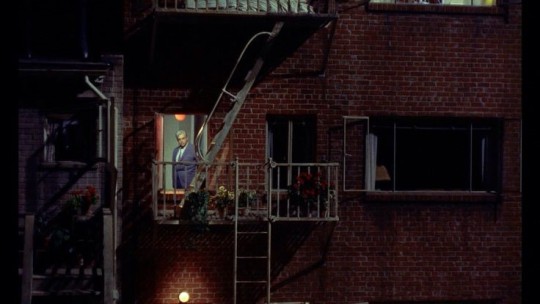
Alfred Hitchcock’s film Rear Window is fascinating to me because of how Hitchcock utilises the isolating composition of a window to highlight specific actions of the villain, and thus build up suspense. The moments in which the villain is present in the three windows and the narrow street alleyway (which is a frame in itself) are of a magnified importance, as they are the only times through most of the film that we see the character and are thus examined and observed intensely by the protagonist. The underlying theme of the film is that of observation, watching and being watched, and to present this Hitchcock does not move the set from the back garden of a set of flats, all the viewer is able to see are through windows. Moments, snippets and sections of peoples lives leak through the openings of their windows, and thus become a subject of great speculation. I want to explore framing through the medium of film, as it allows for movement (obviously). The contents of the window are alive, and thus activate the frame, like we are able to see in Rear Window. The actual proportion of the action that is carried out through the film in comparison to the rest of the shot is 25%. In addition to this, Hitchcock rarely zooms in the frame, unless it is for a realistic interpretation of the protagonist’s own view, e.g. using binoculars or a camera. Thus, the viewer remains the same distance as the protagonist is from his window, reaffirming the idea that we are observing, and infiltrating the lives of the other characters. Hitchcock also utilises the window’s ability to become a void, a vacuum, something that has the capacity to be filled, but is an opening to nothing. The night-time shots show some of the windows in pure darkness, which I find interesting, because unlike the brick wall which we are clearly never able to see out of, the window represents an empty space, thus imagine takes place where action does not, and I would like to investigate this further in my own work through both film and projection, as it allows for other materials to play a role in the absorption of the film, such as placing a projection over a blacked out window.
youtube
The concept of observation is something that I find very inrteresting and that runs through many of my thought processes when making my artwork. How the medium of film allows the passing of time, and thus becomes alive. I feel that Andy Warhol’s screentests have such simplicity that they confront this fact of observance without the distraction of a narrative. The subjects themselves are given freedom, and the request to be as natural in front of the camera as possible. What differentiates these ‘living portrait boxes’[1] from photographs, as Andy Warhol called them, was their vulnerability in presenting the act of living. Warhol has isolated the subjects without giving them any direction, anything to hold onto, and thus they must simply be. The screentests give both a glimpse of the great human qualities that exist in all of us our physical presence that the frames of a moving image will capture, and yet leave open ended the question of performance. We feel truth, yet there seems to be no closure in this. The camera itself is a void, nothing is being given to the subjects, only taken away. The work has the ability to evoke empathy, as we recognise such human qualities in our selves, yet there is a great distance between the viewer and the subject. I want to explore more of this in my FMP, that being the combination of both reality, and the ability to control it.
[1] David Company, Photography and Cinema, Reaktion Books Ltd, London,2008.
Photography has the profound ability to remove itself from its subject. Its subject becomes the object, in the eyes of the viewer, and thus has the ability to dissolve itself from reality, because of its direct creation from reality. First and foremost the photograph is the reflection and exposure of the light of the world. This fact gives its users unimaginable opportunity to transcend our reality, and present something quite far from it to the viewer, who is unable to perceive the difference. ‘whatever it grants to vision and whatever its manner, a photograph is always invisible: it is not it that we see.’[1] I find photography’s ability to isolate, and therefore magnify fascinating because it is not what the viewer is looking at, the viewer is looking in. I have experimented with perspective, composition and orientation to transform ordinary scenes into an image that is able to evoke empathy from the viewer, because of its glimpse into reality, but also force the viewer to think about what they believe they have already seen and subvert that into something they have never seen before. I would like to take this further, through techniques and processes I have learnt at Kingston e.g. exposing a photograph in the dark room, and through the printing workshops, in order to look further into the possibilities of the relationship between window, frame and viewer, and I hope to do this through my final major project.
[1] Roland Barthes, Camera Lucida, Vintage Random House, 2000, p.6
1 note
·
View note
Text
Moira: A Fate Fulfilled
“So it’s always interesting to think back on the ideation of a hero, you know - how do we start, we get that question a lot. And with Moira, it was a little bit of gameplay and a little bit of story. You know - we heard your feedback, you guys wanted a new healer in the game, and we felt the same way. Um, so we really started there. And uh, we have a lot of benevolent healers in the game - we have an angel, we have a monk, a mother, and the most upbeat, like, positive dj that you’ve ever met. So we felt like it was time for something a little bit more morally ambiguous, a little bit more shady. So we started there, and we started with these concepts.” - Arnold Tsang, Moira Reveal Panel (timestamp: 4:52 - https://youtu.be/HsJU3PEk9JY?t=292)
---
Question: yeah, so I know that Tracer was kinda inspired by the “Jumper” class in Titan and all that, and there was a couple of other heroes in Overwatch that were inspired by scrapped classes from Titan, and I was wondering if Moira was one of them, and what other types of abilities or class playstyles from Titan would you like to incorporate into future heroes of Overwatch? Geoff Goodman: Moira’s definitely like - completely [from] scratch, there wasn’t really anything there from Titan, and a lot of them were like that.
---
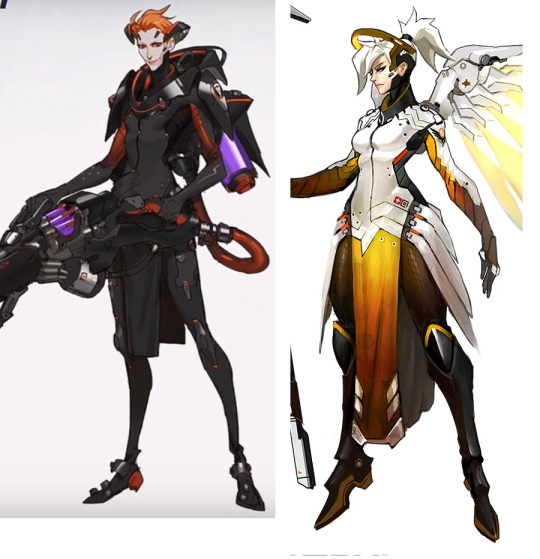
From scratch, huh?
---
In mid-June of 2016, a redditor posted a long and incredibly well-thought out theory, citing in-game interactions and designs, on why they believed Mercy was actually “the true villain” of Overwatch.

You can find the post here: https://www.reddit.com/r/Overwatch/comments/4okg03/a_long_theory_mercy_is_the_true_overwatch_villain/
Perhaps their biggest hypothesis was that Mercy had been the one to incorrectly resurrect Blackwatch Commander Gabriel Reyes/Reaper, which had resulted in an antagonism between the two characters, one representing an “angelic savior” and the other representing “the embodiment of death.” They concluded with:

Yes.
This is where the “Evil Mercy” theory really got started.
I remember it, because it was one of the first big “lore theories” on Overwatch I had ever read.
In time, the “Evil Mercy” or alternately, the “Mercy failed to correctly resurrect Reaper” theory spread pretty far. Among the discussions was a cited interaction between the two characters that people swore they heard in the game. This interaction goes something like this:
Mercy: This isn’t what I had in mind for you... Reaper: You knew exactly what you were doing.
Or alternately
Reaper: Remember, you’re the one responsible for all this. Mercy: This wasn’t my plan for you, Reyes...
Except there was a major problem.
Neither version of these supposed interactions existed.
Fans were baffled. Many people were convinced it existed, or had existed and then been removed from the game. The only source was an early Hammeh video from May 2016, just after the beta of the game launched, in which you can find the line:
Reaper: Don’t forget - you’re the one responsible for this. (https://youtu.be/PoKRFx5Sb5g?t=245)
However, unbeknownst to many fans, Michael Chu had debunked the existence of the exchange for a long time.
“I'm not sure where it came from (maybe there is another line that sounds similar to it), but the "this is not what I intended for you, Reyes" line/exchange does not actually exist in the game.” - Michael Chu, July 22, 2016 (https://us.battle.net/forums/en/overwatch/topic/20747844983#post-16)
The theory continued to spread until Michael retweeted his Blizzard Forums post on his twitter in January 2017 (https://twitter.com/westofhouse/status/822513004784664576?lang=en)
After that, it started dying down.
But it was about that same time that fans of the game began asking for a new support hero -
A morally-ambiguous or even outright evil one. (Real talk, you will get hundreds if not thousands of post on this exact subject if you search “evil healer” or “Talon healer” in the Overwatch subreddit, some as far back as 7 or 8 months ago, so March-ish, and at least a few as old as a year ago).
Most of the fan ideas about an “evil healer” involved some sort of life-leech or life-draining ability in which the “evil healer” could draw health from opponents and then redistribute it to their allies, pretty standard to a fantasy warlock or black mage-type character, except modified for Overwatch’s “firm sci-fi” settings.
Meanwhile, what flew quietly under almost everyone’s radar was the release of Oasis, first onto the PTR in December 2016, and then live servers in January 2017.
As far as I can tell, Hammeh was once again the only source really covering the surprisingly dark and morally ambiguous intent of some aspects of the map. You can find that here: https://youtu.be/6GE11k0X9sQ?t=337.
More importantly -
Hammeh was the first source to compare Oasis directly to the Solder Enhancement Program.
Hammeh: “Remember that...Oasis in the present-day, we’ve had the Soldier Enhancement Program, or whatever took effect on Jack Morrison and Gabriel Reyes for - roughly - twenty-six years or so ago? Given that Morrison and Reyes - pre-his current existence as Reaper, of course - were the products of that twenty-six-year-old program, what could a city of scientists...without perhaps any moral limits on their research, have achieved in Oasis?”
(Congrats on calling it, Hammeh, you deserve mad props) And he brings up a point very near and dear to my heart:
Hammeh: The last known place that we’ve seen Mercy was actually in a Middel Eastern area - I sort of estimated, trying to guess from this map, it could be maybe Iraq or Iran, but what if she was, perhaps, in Oasis? What would she be doing here? But, who knows? It’d be fascinating if we saw Mercy turn up at Oasis at some time in the future. Given that Mercy made big breakthroughs in nanobiology, one wonders if, maybe, she worked with some people in Oasis...or not. Complete speculation, but I could see it working.
Sometime after Uprising, in May 2017, I posted a (rather rambling) essay on how Overwatch was incorporating “horror stories” and “tales of the apocalypse” into the game, even “in fun modes” like Junkenstein’s Revenge. But one of the big points was that I speculated on the possible Mercy-Oasis connections:
http://segadores-y-soldados.tumblr.com/post/159665523340/overwatch-apocalypse-now
The most important one, however, is this set (I cannot find the direct quotes, so I’m basing this off memory but):
Sombra: “What are we doing here?” Reaper: “We’re here to see an old friend.”
Now this is extremely interesting. One of the prevailing fan theories is that Angela “Mercy” Ziegler may have connections to Oasis - she is depicted in the Recall short as being located somewhere in the Middle East, particularly somewhere in present-day Iraq, which is where “the city of Oasis” is located. In the Reflections comic, she is shown to be working on some sort of “active field duty” in a tent that is brightly-lit. In the “We Are Overwatch” short, she rescues a young girl on the edge of a large city with multiple skyscrapers in the background.
I know there is already speculation that, if Mercy is in fact located in Oasis, Reaper is “out for her.” Another version of the theory goes that Reaper is coming to see her to ask her for help with his current state of existence (note that I am not a fan of the “Mercy botched saving Reaper” theory because that has been effectively debunked by Chu).
Because if there is anyone capable of helping Reaper restore himself, it would be “the doctor of death herself,” Angela Ziegler.
We know from Dragons, Recall, Hero, and the Museum Heist that 1) ultimates such as the Dragons and Tactical Visor are canon, 2) Reaper is capable of transforming himself into smoke, 3) Winston’s in-game abilities - including his Rage ultimate - are canon. At the moment, there is no reason to believe that Mercy’s Resurrection ultimate is not canon. People will no doubt argue that I’m making a leap of logic here, but until confirmed otherwise, I’d say it’s likely that all Ultimates are canon.
And therefore this means that Mercy knows how to revive the dead.
More than anything, this means that if Mercy is associated with Oasis, that we should be giving a solid, hard look at what exactly this implies for lore. I’m not saying that Oasis “having Lovecraftian connotations is 100% canon,” but rather it is important to note that the types of references a story builds for itself almost certainly influences the type of story it wants to portray. The fact that Mercy has not one, but multiple skins that are related to “raising the dead in morally-ambiguous ways” is telling. She has two Valkyrie skins, the Imp and Devil skins, and the Witch skin (which literally carries “a book of life” on her).
Again, I already know these skins aren’t canon. That’s beside the point. The point here is that all of this combined creates a very ambiguous tone about Mercy and Oasis - the undercurrents of mistrust, the sensation that “something lurks in the city,” the feeling that “humanity is playing with forces it cannot control,” the idea that “a doctor who defies death” lives and works there, the idea that the “in-game embodiment of Death Himself” is going there to “visit an old friend.” These are all things that build an eerie sense of foreboding.
Exactly as Lovecraft would have wanted it.
Lovecraft’s Nameless City builds the groundwork “lore” for his Cthulhu mythology. The “nameless city” is a city in the Arabian desert, older than Babylon, implied to have been “lost” to the ages as humanity began to conquer the earth. The ancient race that built the city retreated underground, where they continued their worship of the Great Old Ones. The human protagonist of The Nameless City wanders deeper and deeper until he is beset by the presence of the ancient race and some form of the Great Old Ones, ostensibly for “intruding on a realm he had no right to access.”
Sorry for the long quote, but I was ecstatic to see Zenyatta get a Cthulhu-based skin this Halloween, because directly after this Oasis part, I talk about Zenyatta and his connections to “the unknowable.”
What the Overwatch team is building here is a series of “range of canon” background mythologies (some that are “non-canon but merely background white noise that colors how the players view the world,” to “these are kinda sorta canon and you should be paying attention to how we use these references,” to “these are outright canon and we will be using them blatantly for whatever we want”) that develop the world in a set of unique ways. Even for the stuff that “isn’t canon,” it still exists in the game and it still tints how players interact with the characters, their personalities, and their story arcs. Reaper’s Mariachi skins and Zenyatta’s Djinn skins may never matter “in the overall story,” but they still show small “slices” of personality that reveal something new about them. Similarly, Zenyatta’s lines about his discord orb may never “make it to canon,” but they still demonstrate that “something dark” lurks within them.
And this is, arguably, both the strength and weakness of this style of storytelling: anything and everything is open and available for use. You can design a world where a map references the Tower of Babel and more or less imply that “the doctor who defies death” lives there, but you can change this at the drop of a hat. You can create a robot monk whose abilities rely on amplifying “the disquiet” in other characters’ souls, but then say that his statements on these abilities are not “canon.” You can craft a narrative surrounding three old comrades who have had a major falling out and then leave massive gaps in the explanation for this problem. You gain freedom, flexibility, and openness in exchange for lore that stands on a foundation as steady as shifting sands.
It is almost undeniable that Moira fulfills nearly every aspect of these two fan theories: the first of “Evil Mercy” and the idea of her involvement with Reaper’s condition, and the second of “something dark lurks in Oasis.”
Moira is exactly what fans have been asking for -
With all the pros and the cons related to that.
---
In between the first postings of the “Evil Mercy” theory (and Michael Chu’s very soft denial of them) in the Summer of 2016, and the release of Oasis on the PTR in December 2016, a seemingly unrelated fandom event occurred. The large comic book “First Strike,” which was meant to detail the origins of the original Strike Team and their battles in the Omnic Crisis, was canceled.
The original post is, unfortunately, gone now, but bless reddit for having some of the best bots ever:

(https://www.reddit.com/r/Overwatch/comments/5do14r/first_strike_graphic_novel_update_canceled_via/da5z4mb/)
“While we are grateful to the team for the fantastic work they put into it, we’ve ultimately decided to take the story in a different direction.”
And
“In the years since First Strike’s conception, we have done a lot of development on the universe and its sotires. While the core of this story remains, we have changed and expanded upon how we see the events that took place during the first days of Overwatch.” - Michael Chu
Several months later, in May 2017, Jeff Kaplan expanded on that in a Polygon interview:
“We sort of saw Overwatch really open up to the world, and listening to players and the stories they were telling and what they imagined the Omnic crisis to be really made us second guess what we were doing in First Strike,” said Kaplan. “We thought, ‘Hey, if we go down this path, it really closes all these doors.’”
Fan theories about the Overwatch cast’s pasts abound, and players produce fiction, art and other original content in droves. Although animated shorts and digital comics have had success in filling out the game’s universe — particularly the most recent comics, “Uprising” and “Reflections” — the Overwatch team found that a 100-page graphic novel no longer made sense as supplemental reading material, six months into the game’s life.
“Part of the magic is that everything is not tied off and explained to players,” Kaplan said of keeping Overwatch’s canon less defined. “There’s a lot going on in Overwatch right now where I think that the story in players’ heads is often even cooler than what we can deliver to them.”
(https://www.polygon.com/2017/5/17/15655410/overwatch-first-strike-canceled-jeff-kaplan-interview)
Many fans were bitterly (and rightfully) disappointed at the cancellation - the Omnic Crisis is one of the most speculated and discussed concepts from the Overwatch universe, along with the five main heroes (Gabriel Reyes, Jack Morrison, Ana Amari, Reinhardt Wilhelm, and Torbjörn Lindholm) that it involved.
However, the cancellation was quickly followed by a new wave of creator-fan controversy when a fan asked Michael Chu on his twitter if the word “decades” in Reaper’s hero profile was, in fact, accurate or a typo.
You can find the whole exchange here:
https://twitter.com/to_grok/status/826487157430874112
User: Thank you for responding. But does that mean Reyes has been Reaper before Overwatch fell?
Michael: I'll let you draw your own conclusions, but the wording on Reaper's bio is intentional.
The response sparked a massive wave of renewed discussions on the ways heroes and villains are written and portrayed, both in Overwatch and larger media (a discussion I was a part of). People were (rightfully) furious with the implication that Gabriel Reyes - a hero in the Omnic Crisis - had actually been undermining his own organization for “decades” under an alias, or that he had been suffering from wraith-like powers and pain for nearly thirty years without any of his friends and allies noticing. Once the fury cooled down, some people began to toy more with the idea, and the concept that “something had been off with Gabriel” since his involvement in the Soldier Enhancement Program grew quietly among fans.
What was also slowly realized in between the two “controversies” was that there was the increasing likelihood that the “different direction” Michael had originally mentioned in regards to cancelling “First Strike” was actually probably specifically in regards to Gabriel Reyes/Reaper and his eventual role as an antagonistic character in the present storyline of Overwatch. Despite being “villainous,” Reaper is one of the most popular and immediately recognizable characters in the Overwatch cast, and has led to the creation of hundreds of thousands of fanart, fan stories, comics, memes, jokes, videos, posts, discussions, and ideas. Previews of the “First Strike” comic had Gabriel Reyes cast in heavy shadows, looking rather omnious compared to the other characters, and it also showed him in his Blackwatch uniform, a division which hadn’t actually been made yet.
In his late February-early March GDC talk, Michael Chu went on to say this quote about the “villains” of Overwatch:
“What’s important to us is that their motivations are not purely rooted in being evil, despite how they might seem on the surface. As we reveal more about these characters, we want people to be able to empathize and understand their beliefs. Because sometimes what makes a villain a villain is the extent to which they’re willing to go to reach their goals. And one thing that we find most important when we’re talking about our villain characters is that there is nothing to say that a villain cannot be as charismatic or more charismatic or as likeable as a hero character - because, like the old saying goes, ‘every villain is the hero of their own story.’”
The picture during the presentation was of Junkrat and Roadhog, but it was very clear that all of the Overwatch “villains” were a part of this category: Widowmaker, Sombra, and yes, Reaper.
Moira, without a doubt, fits into this category as well, but more than that -
Moira very likely represents some of that “different direction” the Overwatch development team decided on between the game’s release in May 2016 and the cancellation of “First Strike” in November 2016
Especially in regards to Gabriel Reyes/Reaper.
In fact, along with the quotes by Arnold and Geoff listed at the beginning of the post -
I think it’s highly likely that Moira was created as a direct response to everything that has happened between the game’s release and now.
Moira may be the first true “fan-feedback” character created on the Overwatch roster.
The other four characters that have been released since launch - Ana, Sombra, Orisa, and Doomfist - where all largely conceptualized before the game came out, but were staggered for release over the course of a year. While many fans thought they had input on Sombra and Doomfist in particular, it became very clear that, once the two heroes were released, they were drastically different than what anyone expected or predicted.
Moira, on the other hand, covers several things fans have been asking for since at least June 2016: the “evil Mercy”/“evil healer” with a lifeleech ability, a lore connection to the sinister parts of Oasis, a Talon “support” character with moral ambiguity, and a “different direction” that permits the Overwatch developers to possibly give more freedom of morality and a wider ranger of plot backgrounds for other popular characters - chiefly Gabriel Reyes/Reaper, but also Jack Morrison/Soldier: 76, Angela Ziegler/Mercy, Sombra, Genji Shimada, Jesse McCree, Amélie Lacroix/Widowmaker, Akande Ogundimu/Doomfist, etc.
However, she also constricts certain “plot ranges”/“plot twists” now - the revelation by Nesskain that Gabriel Reyes was “scared” over his enhancement or shift into “Reaper” is both surprising and enlightening.

(oh look, a Blackwatch version of the Valkyrie suit.)
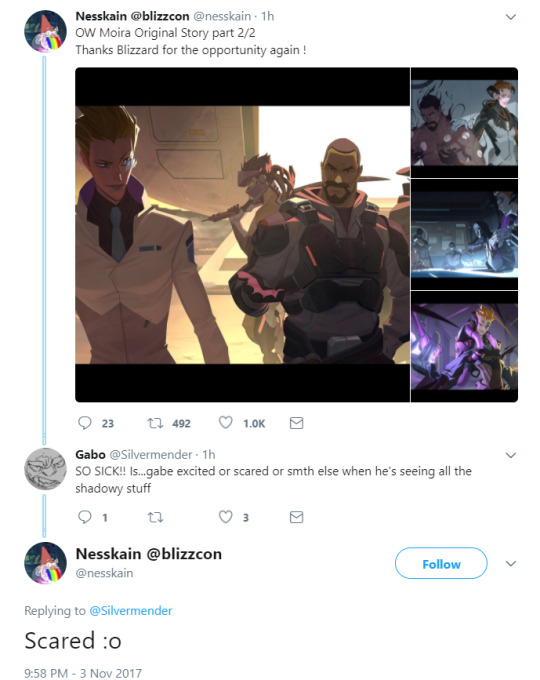
https://twitter.com/nesskain/status/926674887615188992
Now, it’s entirely possible that Nesskain’s comment means very little to the developers, but he did also write that he is permitted to know the “People of interest. And a bit of story” when commissioned to make official art for Overwatch.
Which more likely means he was given the direction to make Gabriel look “scared” during his transformation process.
This immediately relieves some of the pressure that Gabriel Reyes chose to become Reaper, but it now puts the onus on Moira instead, and her decision to possibly experiment on him against his will (or in ways he did not agree to).
To summarize, the timeline of post-game-release events looks like:
June 2016: Major posts on "evil Mercy" start going viral.
July 2016: Michael Chu denies the interactions between Mercy and Reaper exist.
November 2016: First Strike is cancelled.
November 2016: the first few posts on "we need an evil healer in the game" start appearing.
December 2016: Oasis is released on the PTR - Hammeh releases his first video speculating that "someone with darker science" is at Oasis and/or Mercy is at Oasis.
January 2017: Oasis is playable on live servers.
early February 2017: Michael stands by his statement that "the wording on Reaper's bio is intentional."
late February 2017: Michael has his GDC talk - discusses unreliable narrators and “villains” being heroes of their own stories.
April 2017: Uprising is released showing Gabriel Reyes in a more humorous, lighthearted manner.
July 2017: Doomfist is released, revealing more aspects of Talon. Moira is pictured for the first time.
November 2017: Moira is revealed.
---
What this all culminates in is a rather interesting mystery that connects several dots that people have speculated and discussed for quite some time. Most surprisingly, the Overwatch developers actually decided to stick to their guns and put in some very intriguing tidbits that point to a combination of both “reworking” Gabriel Reyes/Reaper’s entire storyline and still “retaining” several details, while still meshing with fan desires and fan theories for a new healer.
Moira’s background and her current “plot” are almost perfectly designed to sell a brand new, well, direction for several aspects of the larger story.
It requires several steps to put it all together.
Step 1. Moira in Oasis

“Currently, in addition to her duties as a scientist for Talon, Moira was also invited by the Ministers of Oasis to become their Minister of Genetics, and so she is basically leading up their genetic research at the city - and this [referring to her Oasis skin] is what she’d wear when she’s over there.” - Michael Chu, 11:12 (https://youtu.be/HsJU3PEk9JY?t=672)

Cool. So now we have a way to tie Oasis to the larger world of Overwatch (again, kudos to Hammeh for predicting that a character like Moira "without any moral limits” on conducting scientific research would come along), as well as expand on the shady and morally ambiguous aspects of the Oasis.
Step 2. Gabriel’s “decades”
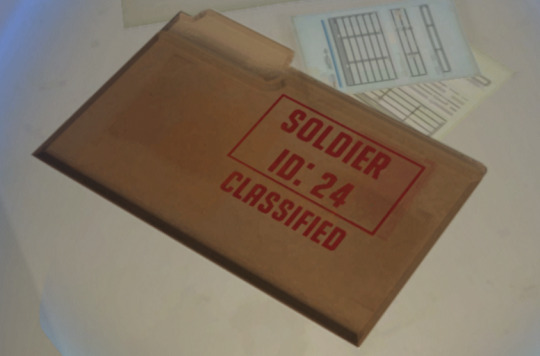
“She was recruited by Gabriel Reyes to be a member of Blackwatch. And uh, during that time she had relationships with the Blackwatch crew - McCree, Genji - they all have their own sort of likes and dislikes for each other. Reyes wanted someone could help advise him on, uh, some matters of genetics that he was, uh, interested in, shall we say.” - Michael Chu, 3:47 (https://youtu.be/HsJU3PEk9JY?t=227)
In Moira’s lab of Genetics on the University map, you can find this folder in the spawn room. It is brand new -
And identical to another “lore detail” found in Dorado.

People have been attempting to predict Gabriel Reyes’ “SEP ID number” since the concept that “76″ was Jack Morrison’s SEP ID number was first theorized. Lots of people picked things like 13 (“unlucky”), 666 (“the Devil’s number”), and 75 (“to go along with 76″), etc - these were all fairly common. This writer picked 127 as a play on a holiday.
What the “Soldier: 24″ folder also seems to imply is that Gabriel has been having issues or side effects from SEP, thus retaining some aspects of his Hero profile saying “decades” on it.
In retrospect -
It’s probably not a coincidence that Michael’s “the wording on Reaper’s bio is intentional” tweet follows the release of the Oasis map onto live servers by like...a month.
It’s also very clear that the Ministry of Genetics was always present on the map, right from the very outset, along with Reaper and Sombra’s interaction about “seeing a friend.”
Sombra: So what are we doing here boss?
Reaper: I need to pay a visit to a friend.
Which certainly played me like a damn clarinet, because man, I fell for it hook-line-and-sinker.
Of course, I was basing my predictions on this next part.
Step 3. “Evil Mercy”

“So, there is a connection [with Moira], but it’s actually not to Zenyatta, it’s actually more of a connection to Mercy. Um, you know, they both worked together - obviously, Moira’s a part of Blackwatch, Mercy was a part of Overwatch, but she’s [Moira] has definitely taken and modified some of that tech. There’s some evidence on the Oasis map that sort of hints at some of that.” - Michael Chu, 3:27 (https://youtu.be/CEQ_qDtyRHA?t=207)
The title of the paper reads “Genetic Conditioning and Regenerative Propertis of Applied Nanobiotics.” - by Dr. Angela Ziegler, MD. Ph. D.
You can also find a copy of Mercy’s research in Moira’s Genetics lab, which is is pretty sneaky way to incorporate the whole “Mercy’s technology failed to resurrect Gabriel” into this whole new storyline. It’s hard to say if Moira specifically used Mercy’s technology (or a warped verison of it) on Gabriel, or if she’s taken Mercy’s tech and reworked it into her own healing beam, but the wink and nod to fan theories about “Evil Mercy” is pretty ingenius and somewhat sinister, Blizzard.
Step 4. A reason to fight
For a very, very long time, there were only two maps that lacked any clear connection to the overarching plot or lore of Overwatch: Ilios, and Oasis. Everything else had some sort of story tie-in, either to a major character or a major event. Sure, many maps lack a specific reason for six people to go brutally fight six other people in a parking lot, like...Hollywood...or Nepal... but they at least had a connection to someone or something.
Up until now, the biggest theory was that - well - Mercy might be chilling there and Reaper might be out hunting for her, but basically overnight that completely changed.
In theory, it would be enough to simply connect the map to Moira and be done with it (much like Nepal is simply connected to Zenyatta), but there’s a unique extra detail in the University map now.
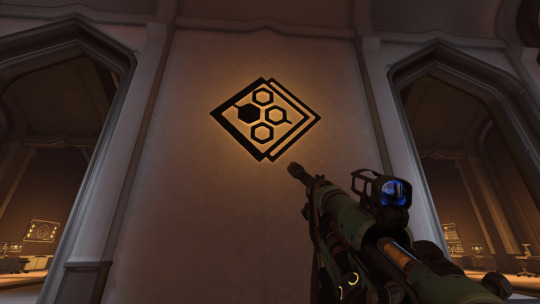
This is the other spawn room on the Unversity map. It mirrors Moira’s on the opposite side.
This is the Ministry of Chemistry logo.

Okay, seems alright, symmetry is important after all.
But there’s...an issue.
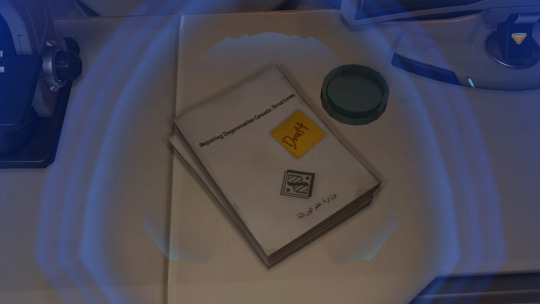
Title: “Repairing Degenerative Genetic Structures” with a large post-it note that says “Draft”
And that -
is the Ministry of Genetics logo
along with the title “Ministry of Genetics” in Arabic.
The “Ministry of Chemistry” spawn room
is this one:

Hmm.
I suspect Moira does not appreciate her fellow Minister running off with her research on a very...unique “test subject.”
And I also suspect “Soldier: 24″ does not want his secrets getting out.
And -
as the “map” from Necropolis shows us -
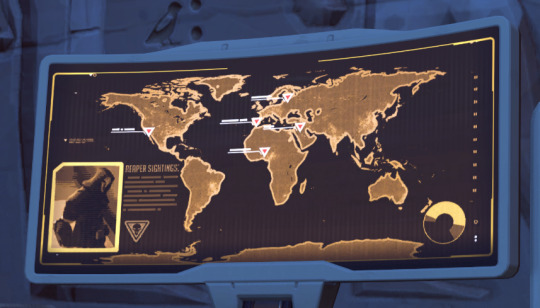
Reaper has to pay a visit to a “friend.”
...Even if she is “the one responsible for this.”
---
And before I get questions about the possibility of a romantic angle between Moira and Reaper, I’m just going to stop everyone right here:
Geoff Goodman: “It [Her Fade ability] has some similarities to Reaper’s wraith form…uh which is…it’s funny how that works out.” Michael Chu: “You know, we obviously - there’s a…there’s a close relationship between Moira and Reyes-slash-Reaper, and I think one of the fun things we were able to do is to sort of hint at some of those things in her, uh, abilities.” Geoff Goodman: “She’s helping Reaper out and is like, ‘You know, I think I could make this better, I have an idea.’” Michael Chu: “Professional relationship.” Geoff Goodman: “Ahaha, yes…good call.” Michael Chu: “You know what I’m talking about.” [Whole panel laughs] - Time: 14:49 (https://youtu.be/HsJU3PEk9JY?t=889)
The tone of the whole exchange makes it very clear that Michael (and Geoff) are emphasizing that the relationship between Reaper and Moira is literally just professional.
And...well...
I also have a username to uphold, so you know my stance on that.
What will be very interesting to see in the near-future are the in-game interactions between Reaper and Moira, as well as Moira and the other Talon members, Moira and the old Blackwatch agents, and Moira and Mercy. Moira absolutely fulfills Michael’s quote here:
Michael: When we created Moira, we wanted her to have all these connections to characters throughout Overwatch history, through different groups. (Moira Reveal Panel)
And, more importantly -
Michael: Who is Moira? Well, most importantly, Moira is that new support hero character that you’ve been waiting for! (Moira Reveal Panel)
Moira is probably the first character created almost entirely from fan feedback and fan ideas, with the developers’ twists, after all.
When Geoff Goodman says that she was created “completely from scratch,” what he most likely means is that the Overwatch development team had no concept of her at the time of the game’s release. She did not come from a scrapped Titan hero. She did not come from a developer’s concept. She did not come from another hero’s background.
She likely came from fan reactions to three main things: the request for a “morally ambiguous healer,” a “different direction” from the original background plot, and a way to enhance the underlying sinister and darker elements of Oasis (if it was not created in tangent with her ideation).
...
So, friends -
Be careful what “heroes” you wish for in the future

Because you might reap your rewards.
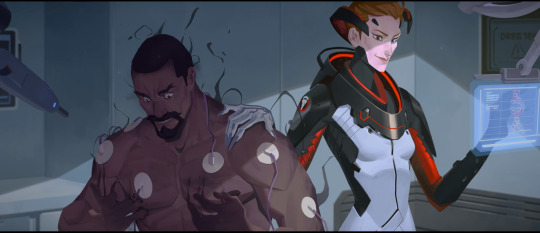
(The Blizzard devs are always listening)
#moira#moira o'deorain#reaper#gabriel reyes#overwatch lore#overwatch theories#my essays#my writing#resources#references#blackwatch#overwatch#oasis#ministry of genetics
442 notes
·
View notes
Text
So you want to build a clan? Chapter 5: Mythos
So we have somewhat covered formation and beginnings, but what about other clan history? By this I mean, what stories do kits hear from the elders? What great events happened in the history of a certain clan? What heroes and Villains are kits taught to be like or admonished not to become?
Each clan culture will have its own understanding of knowledge and virtue, and each clan will thus have positive and negative examples of these. It is important to have some role models which can increase character and clan development.
Canon Examples in this regard would likely include stories in Thunderclan of Firestar, who might be seen as a great hero, and Villains would include Tigerstar and other Dark Forest cats.
But for non-canon clans you have the opportunity to create these stories yourself.
Two quick examples:
Everyone in Ripple clan knows the story of Whiteface. A handsome charismatic tom, he fathered several litters of kits. But there was always one she-cat who had caught his eye, and who he had been frustrated not to call his conquest. Oriolestar was a beautiful shecat, and a capable leader, and he had spent many moons trying to woo her. But she had always been dedicated to her mate, Piketail, and although Whitefaces advances amused her, she always turned him down. One day Whiteface grew enraged, and attempted to attack Oriolestar, but she was too quick, and savage. She subdued him, and charged him with treason. By attacking his own leader, Whiteface had betrayed his clan, and attempted to force himself on another and cause them harm. As a result, he was brought before the clan and punished, forced to run a gauntlet of warriors should he wish to escape alive into exile. While he made it through the gauntlet, he succumbed to his wounds before he escaped the territory. Any kit knows the dire consequences of attacking another clan mate, no matter the cause.
On the other hand, every kit also knows the story of Olive heart, the first code keeper. As a young she cat she was a fiery apprentice, filled with the desire to fulfill the code. However after she was framed for a crime she did not commit, she learned compassion and studied the law of the clan to defend herself before her leader and prove her innocence. She defended herself so well, solving the mystery and implicating the true culprit, that the leader made her a warrior. They granted her the name Oliveheart, for her steadfast devotion to the code, to the clan, and to prove herself. With her extensive knowledge of clan law and code, she became an advocate for justice in the clan, the first codekeeper. In this position she assisted the leader to make accurate judgements of punishment, as well as helped the deputy investigate each situation accordingly, to try and prevent what had once happened to her. The story reminds all kits that with persistence and loyalty, anyone can achieve anything, it is in giving up that the true problem lies.
Alright now with those two you have a good general understanding of personal stories told of cats. Of course these aren't the only ones, but most myths fall into these categories:
Creation Myths:
Every culture has a creation myth, a story of how the world began. In many ways these creation myths are both culturally specific yet often very similar. A creation myth is both the origin and the sum of that clans culture, because it defines the very essence and beginning of it. It affects how Starclan is viewed and even where they believe Starclan originated and why. These can be anywhere from creation by a deity or deities, to an explanation of the seasons, the sun, the moon, the stars, the tides.
Coveclan believes that in the very beginning the world was in darkness, which is why cats have such good night vision. This darkness was a darkness of death and conflict. However one cat, the greatest warrior of their time, fought the darkness, fought death and won. Once they won they ascended into the heavens, and their eyes, filled with the breath and power of life, became the moon and sun, and gave birth to the tides and seasons. In the process, one of their eyes was injured, and although they can hold it open for a time, they must close it to protect it from further harm, this is how the phases of the moon came to be. Cats, the creature from whom the Great One came to be, are their favoured creatures, and those who follow them are also saved from death, and brought to the sky to become the Stars/Starclan.
For inspiration it's helpful to look at creation myths from different religions. While larger religions are useful, smaller, more scattered religions, or sects of larger religions can also offer interesting possibilities.
Hero Myths
As mentioned before, these are the myths which involve the heroes of the clan, the role models of history. Each one will have very specific connotations to each clan, and usually each clan has a different interpretation based on what morals and behaviors are most valued. This can range from aspects of the code which the clans prefer, to how certain suffixes began in the clan.
One of these names which is remembered by Ridgeclan is that of Foxstep. They were the first to ever be given the step suffix, and their story is one that is told to every kit with an animal name. Foxpaw was an apprentice when they saw a fox one day from their perch in the trees. They became fascinated by the fox, but particularly from the fresh prey dangling from its jaws. So Foxpaw began to follow it, learned it's routine, watched it hunt, saw it's den. Then they waited for their opportunity, shadowing the fox one day as it hunted. When the fox caught it's prey, Foxpaw shot out from hiding and stole it from the fox, just as they had seen the fox do before to a wolf. Foxpaw was confident his speed would be enough, except he took a wrong turn and ended up muzzle to muzzle with the fox’s mate. Rookie mistake. They escaped, but lost a muzzle full of whiskers. When they returned to camp, triumphant, with both prey and the location of a fox family’s den, the leader decided that the ordeal could be considered the apprentices last assessment. After Foxpaw helped several warriors drive the foxes out, they were given their warrior ceremony. At the ceremony, the leader spoke:
“Your actions, patience, and skill would normally lead me to name you -whisker, for your exceptional hunting skills. However, seeing as you lost your whiskers to this brazen action, I think you deserve a fitting name. So from this day on, you shall be known as Foxstep. For you walked in the footsteps of the fox itself and survived, and brought glory and prey to the clan in the process.”
From then on, it has been said that those who are named for animals, and study them diligently through their life will take on some of the aspects of the animal itself, and be able to use them to better serve their clan, just as Foxstep did.
Finding examples in our own cultures, is easy as well, and can offer insight in how to incorporate hero myths onto culture. Just look at heroes like Achilles, or Odysseus, or writers like Shakespeare whose names and characters last throughout the ages. These are all names, heroes, characters which all show the culture of the time, and even get adapted as time goes by. It might help to
Mystery Myths:
These are the myths told to explain what cannot be explained,or used as aids to educate young kits to dangers and include them in clan culture. These can be deities, or simply monsters and cryptids.
One example is the creature which the clans call Rot. While the story of its origin is different from clan to clan, ultimately what it is is the same. A malevolent force who is associated with poison and decay. It oozes across the ground in a stinky black mass or a fuzz like clouds, infecting mushrooms and eating dead creatures, and poisoning water and food. Rot holds a grudge against living beings because it can only destroy, not create, and the cats of the clans especially work to create life and happiness. Kits are taught how to scent and identify instances where Rot has touched the world, so that they can avoid it's tricks. Because cats who eat things touched by Rot, or their wounds are touched by Rot itself, risk death.
These stories are sometimes the most fun to write. I mean who doesn't love a good cryptid story? Or a mystery? What these do for a clan, is they address the curiosities which exist in life and in the clans specific territory. So a water clan might have some kind of fish, or an origin story for the pebbles and shells of an inland waterway, or a snake known for snatching kits, or a story explaining why bees sting, or a story about fire, or lightning, or storms. Stories about other predators who are less common, or creatures explaining things like death, disease, cold, pain, growth, birth, etc. So many possibilities to build on!
The most important thing to remember about building the mythos for your clans, is how it will impact your clans. Myths are essentially the main way to educate kits and bring them up in the culture of the clan. Without this mythos, outsiders or cats from other clan will never understand the clan, it's attitudes, or many of the small insinuations or inside jokes, and will have lost serious tools to survive in their environment.
71 notes
·
View notes
Text
Twilight but Gay and also Dark (or Twilight inspired OCS)
Name:Fennel, you can call me Fenn! Used to go by Adra Age: Early 20’s Email: [email protected]. I only roleplay through email. Timezone: I live in almost the smack middle of the USA, so it’s CST I think! I reply at least once a day generally, but sometimes I get caught up in life and can’t reply for a few days to a week or so. :P
Hello!
This ad again, ROUND TWO! I made the same one back in 2018, but everything fizzled out rather quickly due to a lot of extremely personal stuff, and I put roleplaying on hold until I was in a better place and deleted my old LJ account. So here I am again! New and improved and itching to get into the swing of things once more!
If I seem familiar (I used to go by Adra) and we had something lined up, shoot me another message if you’re interested in picking things up again. Or if you emailed me and I never managed to respond, give it a try once more.
Once again, disclaimer: Twilight like, objectively sucks. Let’s be honest. And yet here I still am! I adore it in all its awful, awful glory. Maybe its because I loved it so when I was twelve, who knows. I’m very critical of Twilight and the stuff Meyer wrote into its lore, so you can expect heavy editing on that front. Basics of what I’m looking into: no anti-Native racism, it’s gay, everyone’s older, there’s freaky eerie supernatural mysteries going on in the rainy town of Forks, Washington! We’re giving this thing a complete overhaul, baby. Stick along for the ride if you want!
SUPER long ad, sorry! Just wanna clear out my main ideas first.
In regards to werewolves, we completely nix all of the anti-Native racism she wrote into the lore. Keep in mind that this is essentially a total plot overhaul since so much of it is tied to the original story. The original members of the Pack can still be characters, but they’re just regular humans and allies. ZERO messing with the Quiluete tribe and Native cultures in general. No imprinting. I wanna function more from a standpoint of “real” werewolves mentioned in the series with a couple tweaks: just regular people who turn into werewolves via being bitten and transform under the full moon, but beyond that DEFINITELY not having an entire pack of werewolves be Native or have them all be POC in general with the racist connotations to be made there. Werewolves in general are pretty rare, we stick with the Volturi having hunted them nearly to the point of extinction. This is a plot point later on.
In regards to the Cullens, I’m not into Jasper, sorry. Meyer can try to get me to care about a Confederate soldier all she wants, but that’s not gonna happen. He’s not part of the Cullen coven. Another note: the Cullens aren’t the Cullens! Not all of them, at least. They don’t use being a family as a cover story which is both just really inconvenient in general as a cover and I’m with Jessica on this: it’s weird that they’re all together even if they aren’t related when they’re pretending to be adopted siblings. We also nix vampirism making you white (which, WHAT?? Stephenie. Stephenie.) There are vampires of color! I’m also open to mixing up the Cullens and the other (white) characters in general so they don’t all have to be white, too. Basically just a total overhaul of the racist worldbuilding she put into the series. We’re here to have some fun!
With all that out of the way, you know how Meyer gave Twilight a twist in Life and Death by flipping characters around? We mix and match with that. We go with Beau/Edward or Bella/Edythe instead of Bella/Edward or Beau/Edythe. Or: Beau/Jacob or Bella/Julie, but no love triangles. Here’s what I’ve been thinking for the story, it’s a far cry of what we were shown in the series, so bear with me! I really love the setting of Twilight and wanna run with that. This’ll be more intensive than the original, so hopefully you’re open to that too. I want Beau/Bella and Edward/Edythe to have more of a personality.
All the characters are older, I’m thinking the main characters are mid-20’s or so instead of late teens. For ease I’ll use Beau and Edward as an example but Bella/Edythe can work in place. Beau is an aspiring journalist and returns to Forks to either A) follow a string of mysterious and gruesome murders - hoping both that this will be the big break he’s has been waiting for, and that the town will be more receptive to a press figure if said figure is the kid of long since retired police chief, or B) take care of Charlie, who suffered an injury that caused him to retire from his job and Beau’s nosiness gets him involved with the Forks newspaper joint. Maybe both. Shacks up with Charlie, works on the story, follows some creepy and unnerving leads. Works with the Forks newspaper (possibly with Angela and Eric?), all of the murders are caused by James/Victoria/Laurent.*
Carlisle and Esme are a married couple. Edward is their nephew they took in. Rosalie, Emmett, and Alice are all townspeople but aren’t under the cover story of being a Cullen. We follow some loose storybeats from the OG story, with Beau being immune to Edward’s mind reading powers AND Alice’s future sight (it never made sense to me why Alice could see Bella’s future when Bella had a shield thing going on?), finds Beau’s blood particularly enticing, etc. The Cullens are definitely mysterious and we dig into vampires being like, actually kinda freaky. Beau feels like something’s going on with them but isn’t sure what. Maybe the Cullens ARE involved in some of the stuff and we twist a little bit away from the vampire-vegetarian stuff? Or just keep it the same and they’re similarly involved because the hunting activity has made stuff difficult for them.
Beau crosses a lotta paths with Edward given the nature of his job and Edward/the Cullens all end up somehow or another coming up as he digs into the story. Branches out into either Beau/Jacob, with the Cullens ACTUALLY being involved in some of the murders/disappearances and he and Jake team up to get to the bottom of things. Maybe become a vampire-hunting duo. OR Beau/Edward, where the Cullens are closely involved in the disappearances but aren’t actual killers and he and the coven work together to try and get these wayward vamps out of town. Kill James, Victoria becomes the next villain for a later conflict.
*Laurent becomes a good guy/ally! Doesn’t try to kill Beau/Bella, he sticks to being a cool and interesting dude. Chills with the Cullens sometimes. I feel like he’d be fun lol.
I was thinking there’d be some werewolfism eventually, like maybe Jessica is an actual werewolf (maybe Jake/Jules gets bit too?) and there’s some whole other stuff, but that’s all shelved for a continues story like how Twilight moves into New Moon and the other stuff! Basically a fun rewrite of Twilight where we get into supernatural mysteries and all. :D We can write a whole new storyline.
OR since it’s so heavily divorced from the main series, we just use OCs. Lol.
Anyway, I write in third person in either present or past tense. Don’t have a measurement for my length, I can go from like…four paragraphs to novella. I don’t like writing less than three though. Partners have to be 18+! I won’t write basic immoral stuff (non/dubcon, pedo, incest), general weird fetishes (feet, toilet, etc), mpreg, A/B/O, stuff like that.
I think that about covers everything. Let me know if you’d like to get into this entire Twilight revamp! Pun intended.
0 notes